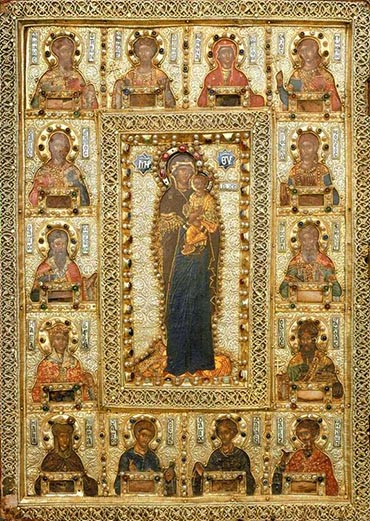
![]()
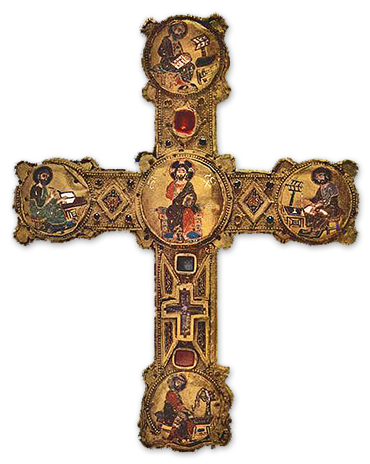
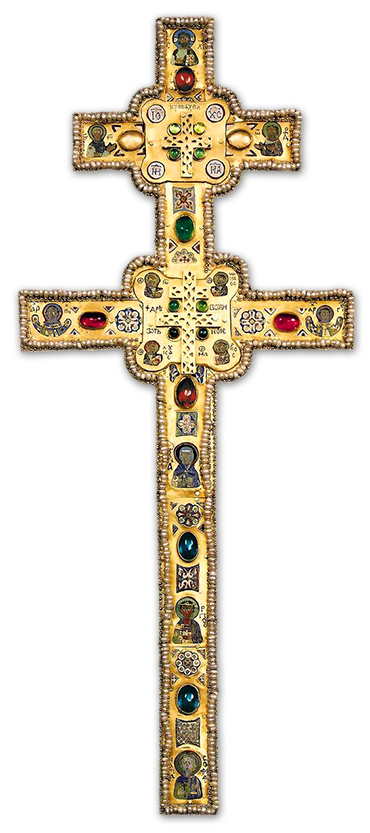
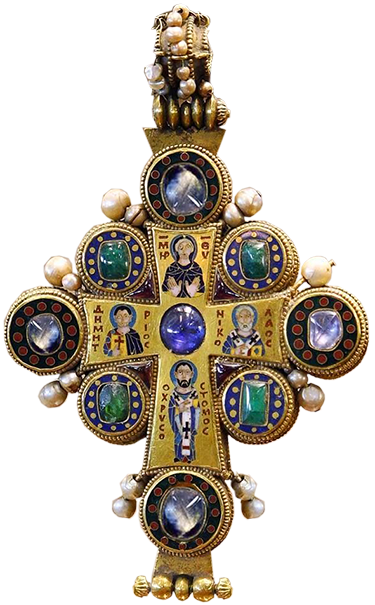
![]()
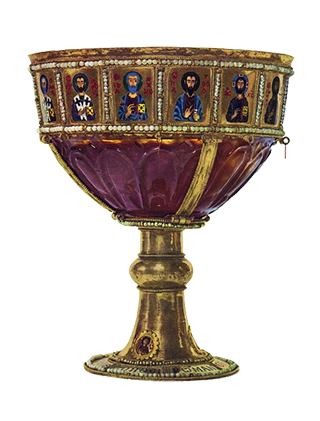
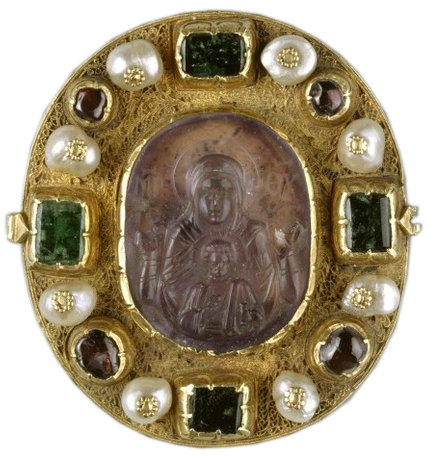

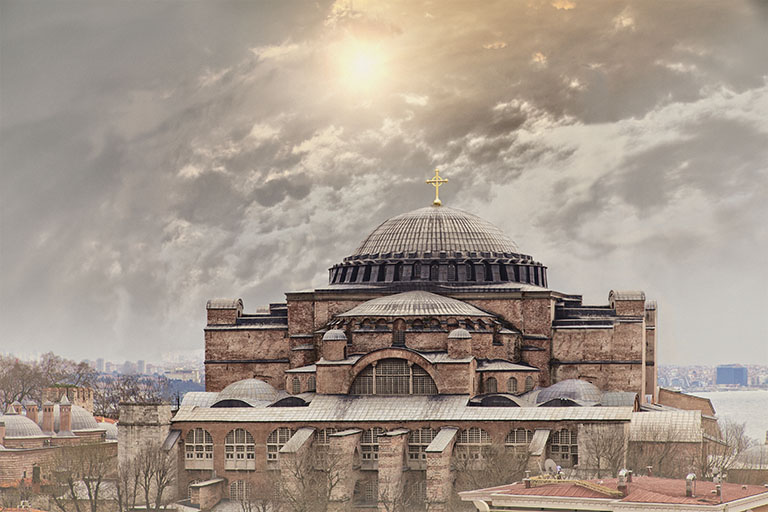
IT HAS BEEN DONE - HAGIA SOPHIA IS A MOSQUE! What will the world do? What will the Orthodox world do?
Now they are claiming the 1934 decree on the conversion of Hagia Sophia into a museum bearing Kemal Ataturk’s signature was forged! God save us from this newest insanity. Erdogan wants to recite the Islamic prayer of conversion himself in the same spot as Mehmet II in 1453.
In September 2018 Turkish courts finally forbade the re-conversion of Hagia Sophia to a mosque. However, just a few months previously, in April, the President of Turkey, Recep Tayyip Erdogan, felt compelled to recite Muslim prayers and praise Mehmet Fatih in Hagia Sophia. I have no idea how independent the Turkish courts are from the President, I assume not much, so this decision must reflect the President's direction on the future of Hagia Sophia. It would be great if this means we can rest assured that it will continue as a museum and the agitation by and demonstrations fundamentalists will stop. It was great to see the recent reports of the visit of the Greek Prime Minister, Alexis Tsipras, to Hagia Sophia and the possibility the re-opening of the Theological School of Halki will happen soon. There is a wonderful 10th century Byzantine church there that might date from the reign of John I Tzimiskes, an Armenian emperor. It has always functioned as a church and was never converted into a mosque.
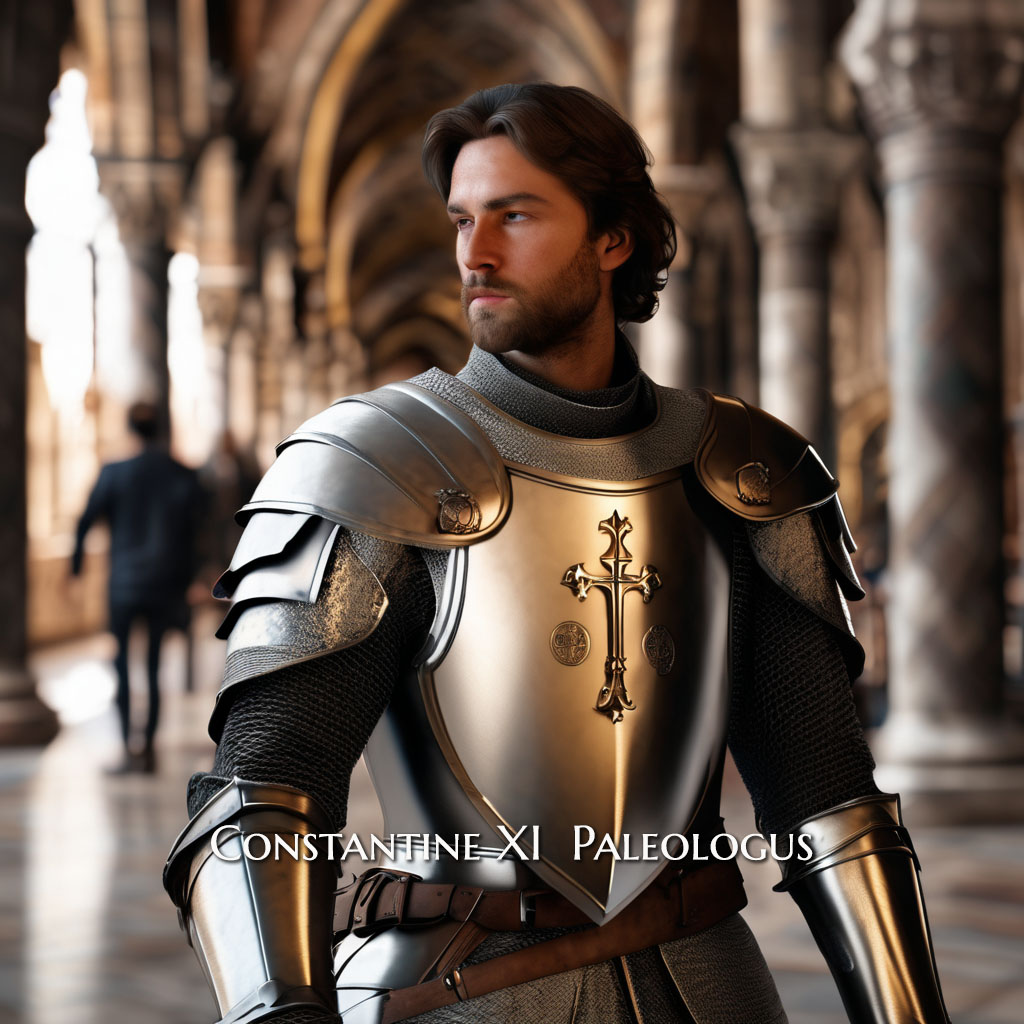 Here is a recent YouTube video from April 2019 that shows the exterior and interior of Hagia Sophia. Much of the inside is obscured with scaffolding and there are partitions cutting off a great part of the church. You can see they were repainting the north typanium inside the nave. You can see the damage the 1845 Fossati oil-painting is still doing to the vaults, which is pealing away and falling in strips. The oil paint cut off the walls and vaults so they could no longer breathe and water was trapped behind it. This destroyed most of the mosaics that were still in Hagia Sophia in 1845, there's more on that below. There are more videos on this page.
Here is a recent YouTube video from April 2019 that shows the exterior and interior of Hagia Sophia. Much of the inside is obscured with scaffolding and there are partitions cutting off a great part of the church. You can see they were repainting the north typanium inside the nave. You can see the damage the 1845 Fossati oil-painting is still doing to the vaults, which is pealing away and falling in strips. The oil paint cut off the walls and vaults so they could no longer breathe and water was trapped behind it. This destroyed most of the mosaics that were still in Hagia Sophia in 1845, there's more on that below. There are more videos on this page.
Everybody understands that Hagia Sophia essential identity is Christian, even Muslims. The modifications to Hagia Sophia to adapt it for Muslim worship have never fit the building and feel awkward and unnatural. From the beginning the Ottomans understood that they were custodians of its Christian past and had a responsibility to preserve it, even as they used it for their own faith. For 300 years after the conquest the mosaics of Hagia Sophia were uncovered, millions of Muslims worshiped under them, undisturbed. This seems inconceivable today, but it is true. The beauty of the architecture and its decoration was treasured by the Sultans, who did their best to protect what they had inherited from the past, even though they had utterly destroyed Byzantium in 1453 and replaced it with a new Islamic Empire.
What you see when you visit Hagia Sophia today depends on what you see. Foreign tourists who don't read Arabic have no idea what the Islamic inscriptions say. Most Turks are in the same boat, thy can't read the Arabic, but they recognize the beauty in the calligraphy and the verses from the Koran that they know they depict. Religious Turks see Islam as a religion of peace and the ultimate fulfillment of Christianity and Judaism. They honor Christ as a Prophet and even respect Christ's mother. All of changes to Hagia Sophia since 1453 are seen by them as positive improvements in line with God's intentions.
 On the right is a Stone Marten, photographed at Hagia Sophia were they live.
On the right is a Stone Marten, photographed at Hagia Sophia were they live.
The Greeks and Orthodox Christian visitors have a different experience in the church today which is totally foreign to what Turkish Muslims see. Hagia Sophia is still the center of their history and faith and the church is in captivity to another religion. They I have actually witnessed Muslims confronting Greek tourists saying - "Stop dreaming - you will NEVER get it back". It seems Hagia Sophia is right on the fault line between Christianity and Islam, East and West. Now that the future of Hagia Sophia seems assured for the foreseeable future we can all share Hagia Sophia regardless of our religion (or lack of one) as our common heritage, something we can all enjoy and learn from. One can hope the museum workers of the Aya Sofa Museum will get all the support they need to conserve and present it to the public. The hordes of tourists that descend on the museum everyday are a great responsibility!
It has been 565 years since the last Christian service in Hagia Sophia. Everything that gave Hagia Sophia its meaning as a church - the celebration of the liturgy and the worship of Christ - was brought to an abrupt halt in 1453 when the last candle was extinguished and the final Eucharist was swept from the altar. It was the absolute end to a long history and unique culture. We can still imagine what a service was like in Hagia Sophia. Liturgy in the church was sung - there is a ten second reverberation in the church that makes it hard to understand the spoken voice. Singing services were invented for the church. The choir of Hagia Sophia in the 7th century had 160 singers. Hymns and chants were composed for the church and followed the hourly services that were held in the church. Hagia Sophia was a processional church; bishops, clergy, and choristers lead the people into the church carrying crosses and icons with clouds of perfumed incense, spread by swinging and gently clanging silver censors. This was combined with the light reflected from the golden vaults and the beautiful mosaics and other artwork in the church that also reflected light. The Holy Altar was covered in glinting silver and gold and set with rich jewels and pearls. Finally the splendid rich marble revetments and columns all added to this unique experience of worship and wonder. In its current circumstances Hagia Sophia is like a bombed out Opera House.
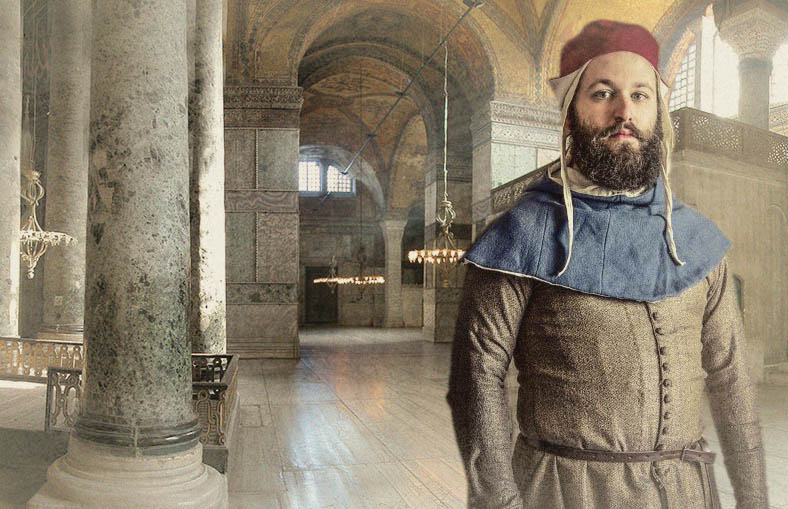
Most of the people who visit my site are either planning a trip to Istanbul and want to learn something about Hagia Sophia - or they have been and want to learn more about what they've seen. First time visitors to Hagia Sophia notice a few things. The church is not so impressive from the outside, especially when compared to the other nearby Ottoman mosques. I have never understood why it is either painted red or left with exposed brick. In Byzantine times the exterior of Hagia Sophia was covered in panels of white Proconnesian marble, a few still survive on the front wall facing the vanished atrium. The areas of exposed brick and fieldstone were stuccoed and painted blue, while the dome and great cross were gilded.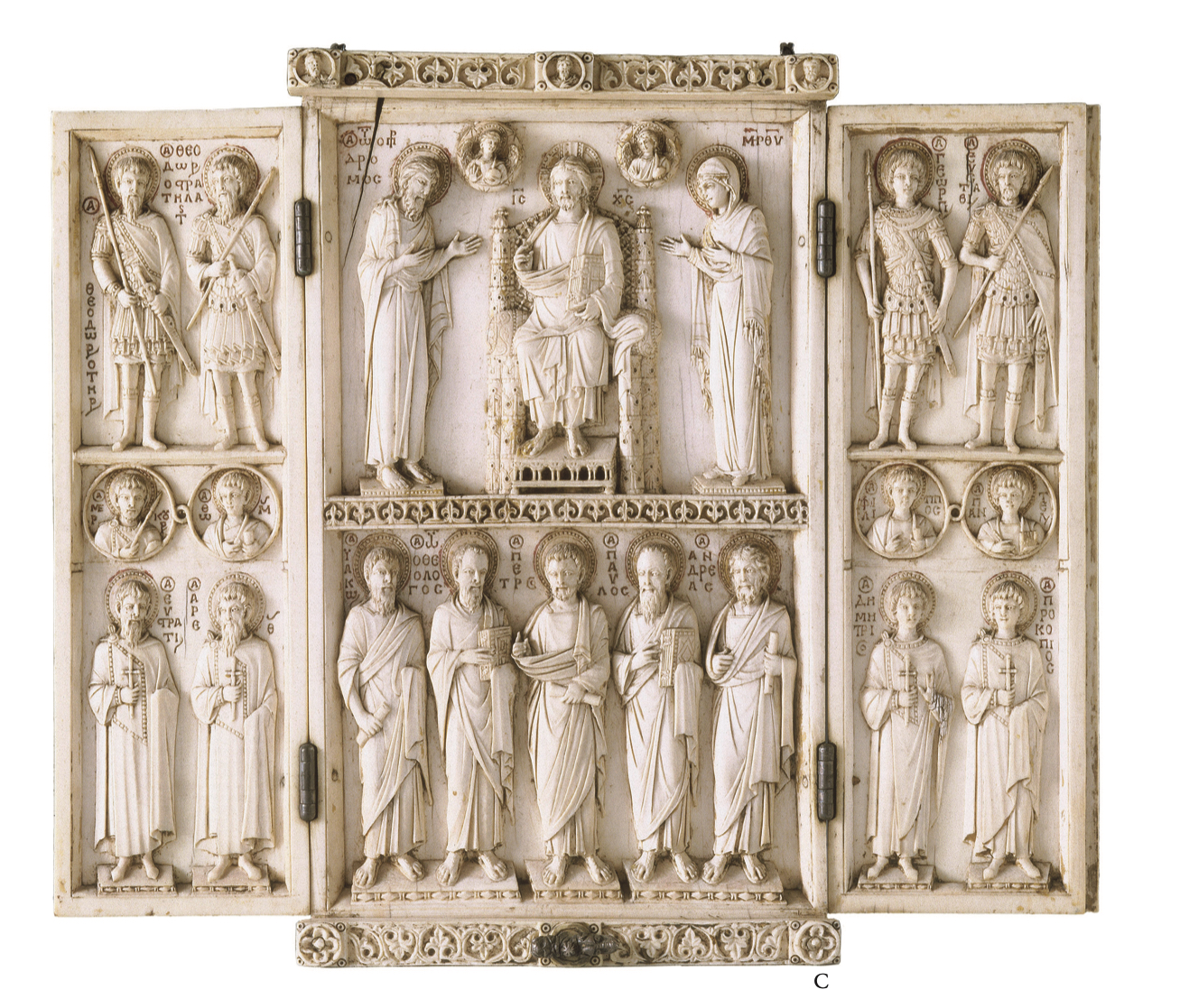
Once you are inside the nave it feels dark. This isn't the way it always was. The darkness is caused in part by the closing up of so many windows by the Turkish architect Sinan in the 16th century. There used to be much bigger windows in the tympana with huge tripartite windows near the top of the arches, that Sinan filled in. Windows have been closed up in the dome and elsewhere. Buildings that were erected outside the building - a score of Muslim tombs - along with massive buttresses also obscure the light coming in. The Fosatti brothers were responsible for the stained glass windows we now see in the apse, so those are 19th century changes that has reduced the light even more. It has been estimated that Hagia Sophia now has 70% of the light it did when it was built.
The huge window frames were originally made of marble. A few of these have survived but most of them have been replaced by frames molded in stucco.
In Justinian's time all of the windows were set with large square panes of opaque light bluish green or light green glass. Pane glass had been widely used since 1st century Rome and have been found in the excavations at Pompeii and Herculaneum, where it has been discovered in original wood frames. 500 years later pane glass was still being used in buildings all over the Byzantine Empire, pieces of windows, even entire panes, have been found everywhere. Mass quantities of window panes were produced in Palestine, Asia Minor, Egypt, and they were used in both public buildings and private homes. There were stores that sold window glass, one from the 6th-7th century was excavated in Sardis where they found thousands of panes in the ruins of two shops where it was still stacked awaiting buyers. From Justinian's edicts we know that there were glass factories in Constantinople located outside the city walls for safety reasons. Pane (later transparent glass was used) glass continued to be used in Byzantine buildings right up until 1453. It is even possible that some of the Byzantine window glass survived in Hagia Sophia until the 18th century or later in the great apse windows.
Today the glare of modern lighting makes all the oddities and imperfections of Hagia Sophia stand out. LED lighting is especially bad. Today there are electrical cables all over the place. The graceful Ottoman chandeliers are disfigured by wiring. I think the museum authorities should relight Hagia Sophia in a more sensitive way. In 2014 Mehlika Inanici published a highly detailed study of lighting in Hagia Sophia and how it looked in natural and artificial light throughout its history. I never knew there was so much to learn on this subject. Mehlike has shown that electric lighting during the day is ineffective and mainly illuminates the chandeliers and the floor. She recommends only natural light be used during the day and artificial at night, except for cloudy days and early mornings.
To learn more about the illumination of Hagia Sophia in Byzantine times click here.
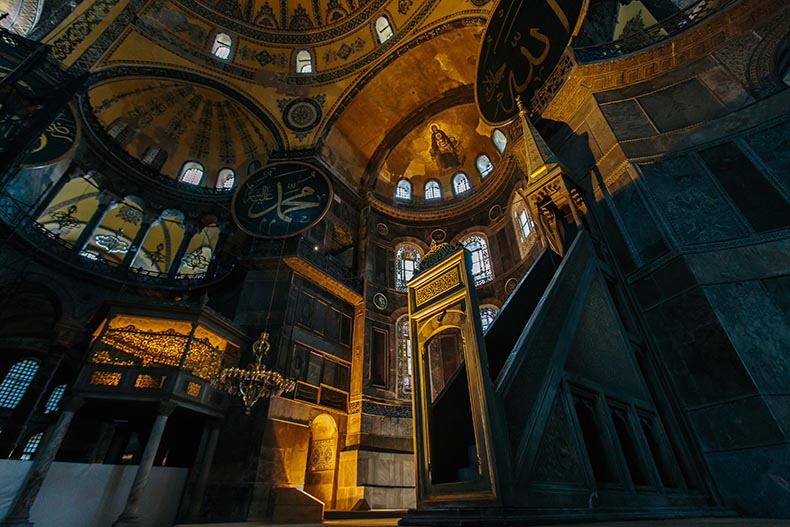
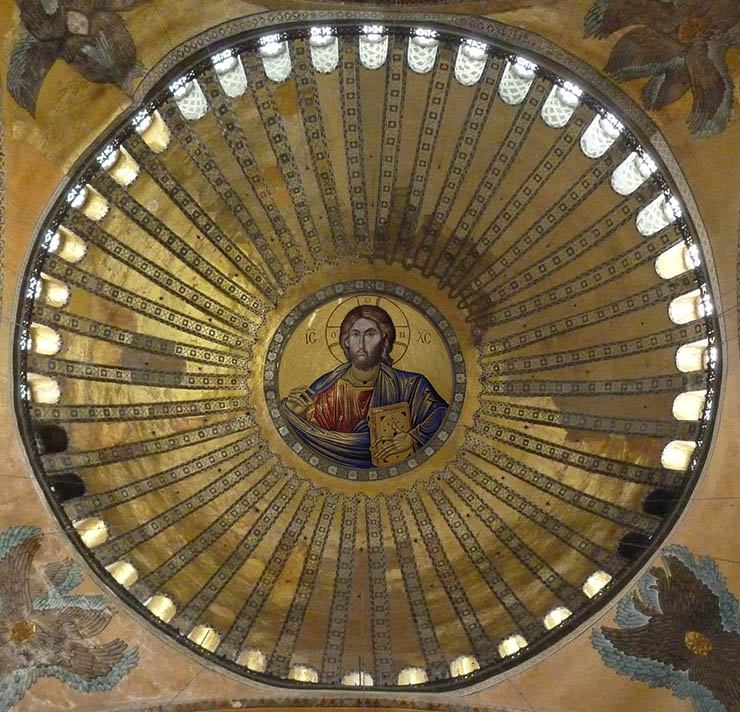 dome as you see it in 2020 and a reconstruction
dome as you see it in 2020 and a reconstructionThe dome was never meant to be blasted with artificial light which focuses attention on every flaw there. Above a view of the dome that demonstrates this. You might notice the mosaic of Christ in the summit of the dome. I digitally restored it with a 14th century face from the narthex of the Chora church. I think that is a great choice because it is close in date and has the same broadly modeled face we see in one of the surviving Seraphim.
One can actually make out the segments of the dome that were replaced parts that fell in the 10th (upper side) and 14th centuries (lower side). 80% of the mosaic in the dome is still there, 20% has been replaced with paint and plaster that has become discolored. Much of this work dates from 1894-1907 so it is not old and very recent. Humidity and pollution are also causing some of the surviving Byzantine gold mosaic to shed its protective layer and 'tarnish'.
In the pendentives are the gigantic winged Seraphim. The one on the bottom left has its original face, which was uncovered around ten years ago. Three of the Seraphim survive in mosaic, one of them has only the top tips of the wings. The upper right Seraphim is entirely done in oil paint and is Ottoman. There is paint peeling everywhere, is this any way to treat Hagia Sophia? My proposal - replace all the 19th and 20th century plaster and paint with plain gold mosaic and leave the beautiful Islamic calligraphy in place. Instead of repairing the dome over and over again with new paint, why not use plain gold mosaic? Right now it looks like an archaeological site - or even a disaster zone!
I have added a page on the dome with plans - you can read it here.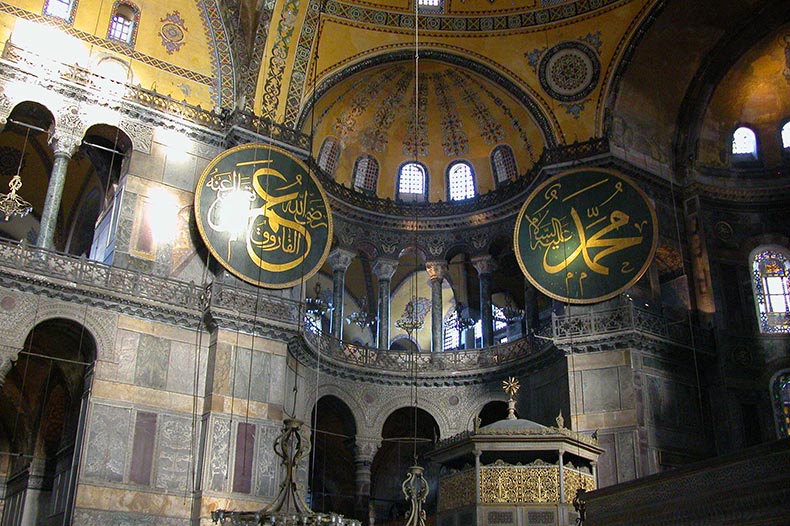 The great shields in Arabic carry the names of Muhammad and the first conquering Caliphs of Islam. They are the largest of their kind anywhere in the world and celebrate the fact that Hagia Sophia was taken by force of arms and is a war trophy.
The great shields in Arabic carry the names of Muhammad and the first conquering Caliphs of Islam. They are the largest of their kind anywhere in the world and celebrate the fact that Hagia Sophia was taken by force of arms and is a war trophy.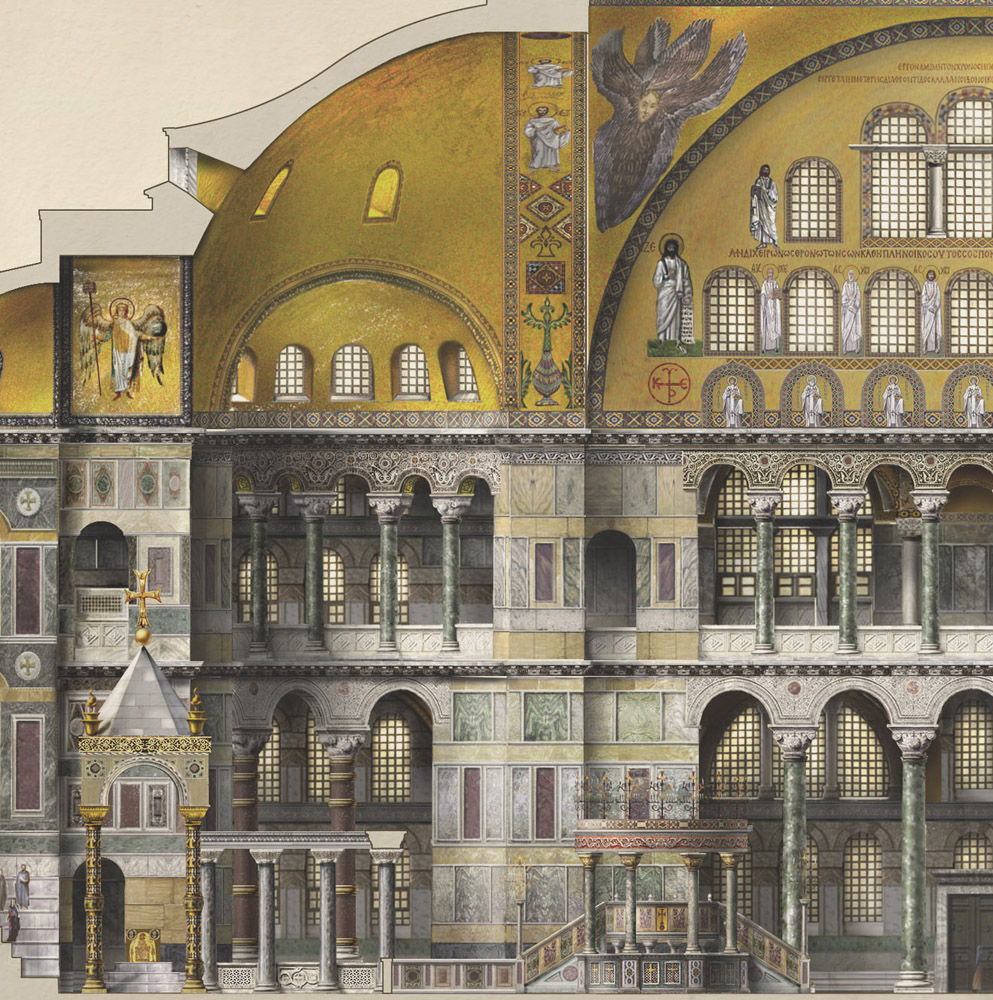
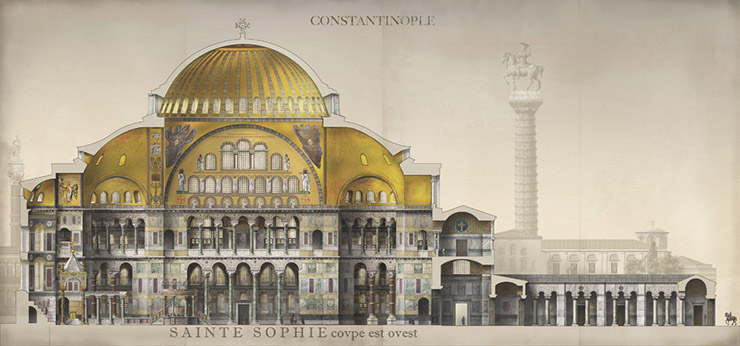 The vaults used to be covered with gold mosaic. Now they have been replaced with the most ghastly oil paint colors - horrible dirty ochres that are constantly peeling. They keep trying new colors but nothing works. They spend so much on painting it that it might be better just to replace the paint with mosaic. The psuedo-Justinianic stenciled ornaments look dreadful, too. Why not get rid of them? These designs are recent - they were a part of a redecoration scheme from 1848 to make Hagia Sophia look more Gothic. Yes, Gothic. The guys who did it were the Fossati brothers, Gaspari and Guiseppe, Swiss Italian architects and decorators. In 1847, Sultan Abdülmecid appointed them to renovate Hagia Sophia and it took two years. It is claimed they saved the building from imminent destruction. Today you can see the results of their structural improvements all over the building. During their work many of the mosaics were revealed to the astonished eyes of the Fossatis as well as Sultan Abdülmecid. The Sultan ordered drawings and watercolors done of the mosaics before they were covered up again. These drawings are in the are kept in the Cantonal Archive of Ticino. Since then Hagia Sophia lost 70% of the figural mosaics that had survived. It's funny but we don't know how this happened. There was a great earthquake in 1894 - did that bring them down? You would think that an earth-shaking - in more ways than one - event like an earthquake destroying 1000 year old mosaics would have reported in the press, but it wasn't. You would think there would be records of a massive clean-up in Ottoman records.
The vaults used to be covered with gold mosaic. Now they have been replaced with the most ghastly oil paint colors - horrible dirty ochres that are constantly peeling. They keep trying new colors but nothing works. They spend so much on painting it that it might be better just to replace the paint with mosaic. The psuedo-Justinianic stenciled ornaments look dreadful, too. Why not get rid of them? These designs are recent - they were a part of a redecoration scheme from 1848 to make Hagia Sophia look more Gothic. Yes, Gothic. The guys who did it were the Fossati brothers, Gaspari and Guiseppe, Swiss Italian architects and decorators. In 1847, Sultan Abdülmecid appointed them to renovate Hagia Sophia and it took two years. It is claimed they saved the building from imminent destruction. Today you can see the results of their structural improvements all over the building. During their work many of the mosaics were revealed to the astonished eyes of the Fossatis as well as Sultan Abdülmecid. The Sultan ordered drawings and watercolors done of the mosaics before they were covered up again. These drawings are in the are kept in the Cantonal Archive of Ticino. Since then Hagia Sophia lost 70% of the figural mosaics that had survived. It's funny but we don't know how this happened. There was a great earthquake in 1894 - did that bring them down? You would think that an earth-shaking - in more ways than one - event like an earthquake destroying 1000 year old mosaics would have reported in the press, but it wasn't. You would think there would be records of a massive clean-up in Ottoman records.
I believe the methods the Fossatis used in the restoration doomed the very mosaics they thought they were saving. After exposing and recording them they hastily recovered the mosaics with plaster and then painted a heavy thick layer of oil paint on top of it. This layer of oil paint sealed the moisture in behind, it could not breathe. Soon the paint layer began to peel everywhere, all over Hagia Sophia. The back-up of moisture detached the layers of Byzantine plaster and mosaic from the brick walls; when the earthquake of 1894 hit, this must have all come down. Perhaps the damage of 1894 caused the mosque authorities to scrape anything that looked like it couldn't be saved. All of the mosaics in the vaults of the South Gallery were lost. They simply vanished. Was it laziness? Was it was easier just to pull them down rather than save them? Was there some salvage value in the glass? Recent exploration in the dome has shown the extensive restoration of mosaic there after 1894. Discovering the fate of them won't bring these lost mosaics back, but it would help us repeat a mistake like this in the future.
The huge Islamic disks with inscriptions of the names of the first Caliphs are totally out of scale to the building and ruin the interior. They are additions added during the Fossati restoration, during earlier Ottoman times these plaques were much smaller and fit into the architecture better. Unfortunately Turkish nationalists want as many Islamic inscriptions as possible in Hagia Sophia, and as big as they possibly can be, so those ghastly things are going nowhere.
I have always liked the Sultan's Box - it too is a recent addition, built for Sultan Abdülmecid. This is one of the chief targets of the Islamic zealots who want to convert Hagia Sophia into a mosque again. They want the Sultan's Box opened as a private Islamic chapel so they can pray in it.
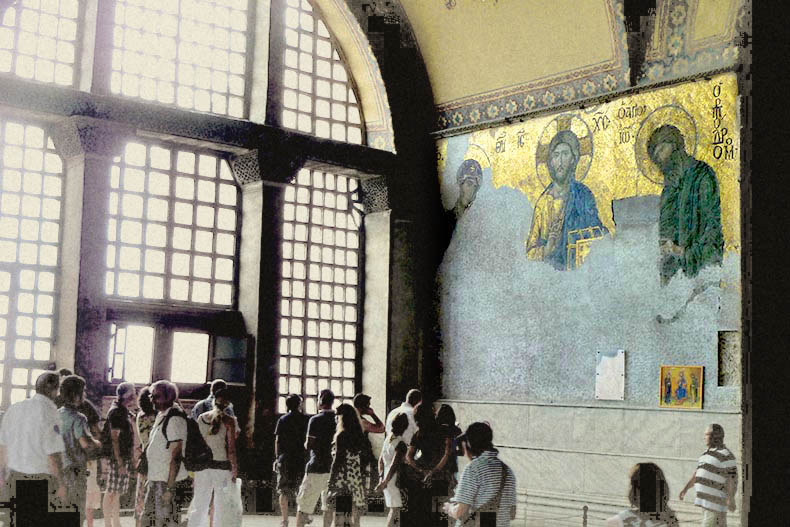 explaining all the imperfections and oddities
explaining all the imperfections and oddities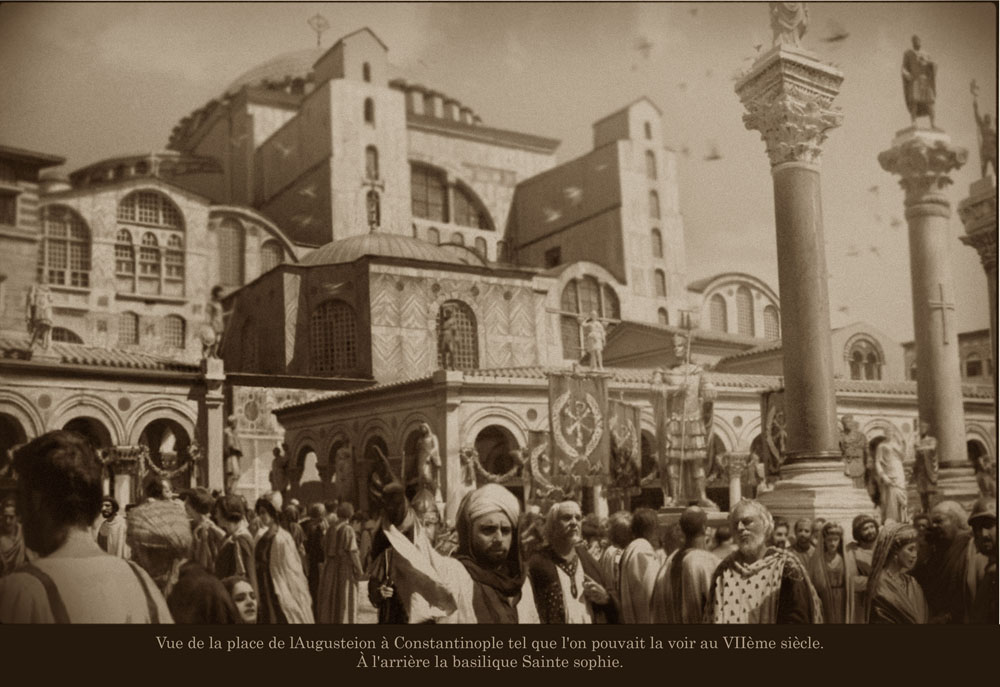 Another thing that disturbs visitors to the building are the imperfections in the vaults and the dome. The curve is not perfect. The dome - and parts of the semi-domes - fell three times over the centuries. The most 'recent' was the collapse of 1346 that brought down a part of the eastern arch with part of the dome. The Emperor John and his wife Anna had to beg to raise the funds to do the repairs - what was left of the empire could not finance them. The Russians and other Orthodox princes gave money and the repairs got done.
Another thing that disturbs visitors to the building are the imperfections in the vaults and the dome. The curve is not perfect. The dome - and parts of the semi-domes - fell three times over the centuries. The most 'recent' was the collapse of 1346 that brought down a part of the eastern arch with part of the dome. The Emperor John and his wife Anna had to beg to raise the funds to do the repairs - what was left of the empire could not finance them. The Russians and other Orthodox princes gave money and the repairs got done.
Some of the other oddities about the decoration of Hagia Sophia can be seen in the narthex where some of the motifs and the crosses don't match. There are other places that have sloppy workmanship. This is strange - there are parts perfectly executed next to work that looks cruder. Recently, the Byzantine scholar, Natalia Teterianikov, has discovered that while Hagia Sophia was built, in 536-537 there was a period of global disruption caused by a major volcanic eruption that covered the earth with a veil of ash. Historians of the time, like Procopius, have reported it. Today it is called the Mystery Cloud of 536. One of the effects of the eruption was the reduction of light to only 4 hours a day. Global cooling also increased the drying of plaster, which had to laid in smaller patches. Taking a dangerous risk, some marble elements in the church might have been carved by lamplight. Mistakes would not have been visible to viewers on the ground, so they were overlooked until the darkness lifted and work was almost completed. Then it was too late to do anything about them.
The original cathedral of Constantinople had been the Church of Hagia Eirene - "Holy Peace", which was built originally by Constantine I in 337. The current church was rebuilt in the 8th century after an earthquake. It stands alongside Hagia Sophia on the north side of the church. It is still famous for its apse mosaic of a simple gold cross on a silver background, which was set up during Iconoclasm. In Ottoman times the beautiful marble columns of the nave were taken for the building of new mosque and substituted with a bunch of mismatched shafts. All of the marble revetment of the church was also removed at the same time and was reused elsewhere. Today the church is barren and stripped, the ground level has risen dramatically and Hagia Eirene is now deep in the earth. Hagia Eirene survives today because it was never converted into a mosque and was used as a military arsenal by the Janissaries, the special elite Ottoman military unit made of first-born Christian boys who had been taken from their families. During Ottoman times many relics of old Byzantine Constantinople were brought here for safe-keeping. You could find the great iron harbor chain that had protected the city and the porphyry tombs of the emperors that had been brought here when the Church of the Holy Apostles had been demolished by Memhet II. In recent times it has been used for concerts.
The first Hagia Sophia was built alongside Hagia Eirene in 360 during the reign of Constantius II and soon eclipsed it. Justinian's church was the third on this site, the previous two had burned, both of which had been roofed basilicas. The second one was built in 415 by Theodosius II. Remains of this huge, five aisled church, including a beautiful marble propylaeum with carvings in the neoclassical style of the time, were excavated in early in the 20th century and can still be seen in the atrium. Here we see a charming frieze of sheep processing into the church, following the Good Shepherd to find salvation inside.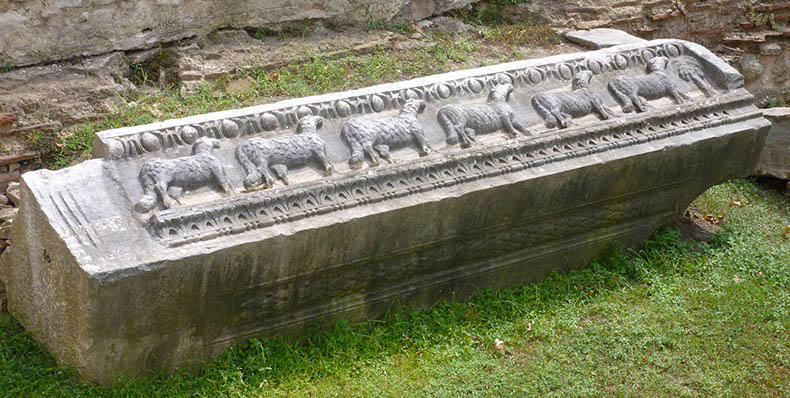 Each version of Hagia Sophia was an improvement on the earlier one in it's beauty and decoration. The last one was vast, it was built for huge crowds that attended services here. Right in the heart of the city and popular with the rabble as an assembly point, it became the frequent center of conflict with the Imperial court and the bishops of Constantinople, who were based here. The first Hagia Sophia was burned down by supporters of John Chrysostom in 404 in revenge for his exile by the Empress Aelia Eudoxia, who he had criticized for immorality and meddling in politics and church affairs. She was married to the emperor Arcadius, a worthless non-entity, but had probably born at least one of her children with another man. Bishop John preached his last sermon from the ambo of the Hagia Sophia; that same day, after he had been forcibly removed from the church fire erupted from the spot were he delivered it. The flames shot up from it to the chains where the candelabra where suspended and spread all over the church from there, burning it to the ground. This was not the first time disaster hit Constantinople because of the John - Eudoxia feud. Once before she had him deposed. On that very day there was an earthquake in the city! Eudoxia should have learned the first time. John Chrysostom died in exile and was canonized by the church. A life-sized mosaic of him was put in the tympana of Hagia Sophia which survives to this day.
Each version of Hagia Sophia was an improvement on the earlier one in it's beauty and decoration. The last one was vast, it was built for huge crowds that attended services here. Right in the heart of the city and popular with the rabble as an assembly point, it became the frequent center of conflict with the Imperial court and the bishops of Constantinople, who were based here. The first Hagia Sophia was burned down by supporters of John Chrysostom in 404 in revenge for his exile by the Empress Aelia Eudoxia, who he had criticized for immorality and meddling in politics and church affairs. She was married to the emperor Arcadius, a worthless non-entity, but had probably born at least one of her children with another man. Bishop John preached his last sermon from the ambo of the Hagia Sophia; that same day, after he had been forcibly removed from the church fire erupted from the spot were he delivered it. The flames shot up from it to the chains where the candelabra where suspended and spread all over the church from there, burning it to the ground. This was not the first time disaster hit Constantinople because of the John - Eudoxia feud. Once before she had him deposed. On that very day there was an earthquake in the city! Eudoxia should have learned the first time. John Chrysostom died in exile and was canonized by the church. A life-sized mosaic of him was put in the tympana of Hagia Sophia which survives to this day.
The church built by Theodosius II in 415 was destroyed in a riot of Hippodrome circus factions which had gotten out of control. The circus factions were fighting all the time which let off steam and was therefore usually tolerated by the police. This time it got out of control turning into a dangerous revolt which attempted the overthrow of Justinian and Theodora. It was called the Nike Revolt. Nike means victory and the rebels made it their rallying cry. After they burned down a large part of the center of the city and crowned a new, very frightened emperor, Justinian brutally suppressed the revolt by sealing the rebels in the Hippodrome and killing at least 20,000 of them. The rebel emperor was executed. The center of the city was now a smouldering ruin and their were piles of corpses to deal with.
The destruction of Hagia Sophia allowed Justinian to start over again with something fresh and completely new on a scale that had not been attempted before. There was not to be another wooden roof for obvious reasons - there was never to be another fire. The scale of the building - and its expense - tested the abilities of the Emperor's engineers and his ability to finance it. Fortunately, when he started rebuilding Hagia Sophia Justinian was flush with gold from the Vandal treasury which he had just captured during the reconquest of North Africa. Vandal gold had been amassed from their earlier sack of Rome, so it was ironic that Justinian was taking it to the New Rome. This bonanza meant that Justinian could easily afford to pay cash to his contractors for their work.
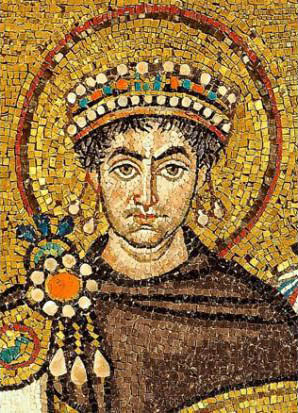 After building Hagia Sophia Justinian is best known for his marriage to the former prostitute and stage actress, the beautiful Theodora, whom he made an empress. Justinian came from a humble background too, he was the son of a peasant and a soldier. Latin was a his native language, not Greek. He came to the throne because his uncle was emperor. Justinian had already built some cool buildings, including Saints Sergius and Bacchus, which was attached to the Hormisdas Palace where he and Theodora living before he became emperor. It still stands as a mosque with its amazing dome and delicate carvings.
After building Hagia Sophia Justinian is best known for his marriage to the former prostitute and stage actress, the beautiful Theodora, whom he made an empress. Justinian came from a humble background too, he was the son of a peasant and a soldier. Latin was a his native language, not Greek. He came to the throne because his uncle was emperor. Justinian had already built some cool buildings, including Saints Sergius and Bacchus, which was attached to the Hormisdas Palace where he and Theodora living before he became emperor. It still stands as a mosque with its amazing dome and delicate carvings.
Going far beyond what had been done there, Hagia Sophia would be the biggest Christian church in the Roman Empire and boast the largest dome ever built until the Renaissance. Sergius and Bacchus could have been fit inside Hagia Sophia with room to spare! No expense would be spared in making it the most beautiful building in the world. Plans and dreams aside, there could be challenges in paying for the project once it was underway. Even though there were those rivers of gold flowing into his coffers from his conquests, Justinian spent it faster than he got it. Imperial revenues doubled during his reign, but so did the expenses of running the Empire. His new conquests were not all profitable, some like Italy were net losses on the balance sheet. North Africa was the only bright spot that had paid for itself. Justinian ran out of money and had to scramble to keep soldiers in the field and feed them. Bad stuff like earthquakes were destroying major cities like Antioch that had to be rebuilt.
It took only five years to build Hagia Sophia. The building went up swiftly and had its formal consecration on December 27, 527, just five years after the work began in 532. It was a huge event in the history of Constantinople. The people of the city witnessed its construction first hand and followed all of the challenges and problems that arose in its construction. In later times a mythology would be developed around the building of the Great Church and the divine hand of God and His Angels would be seen in its brick, mortar and marble.
Five years later, combining a daring design with the richest materials the Empire could offer, the third - and final - Hagia Sophia was dedicated by Justinian at Christmas in 537. It is said that he uttered "Solomon, I have surpassed you" at the opening of the new church. Indeed, Hagia Sophia was a latter-day Temple of God. Its full name in Greek was Ναός της Αγίας του Θεού Σοφίας, Naos tēs Hagias tou Theou Sophias, which means "Shrine of the Holy Wisdom of God" (thank you Wikipedia). In the form Justinian gave it Hagia Sophia was much larger, more beautiful and daring than the Temple in Jerusalem, even the second marble temple built by Herod. Was he relieved to see the project done, was he satisfied with the results? What he said at the opening of the church seems like genuine amazement and pleasure at what he had accomplished.
Through many, many vicissitudes Justinian's cathedral church for Constantinople still stands, its soaring vaults and amazing dome are a testament to the human spirit, the engineering talents of its builders and the kindness of those who have treasured and preserved her over the centuries. You can read a beautiful description of Hagia Sophia written in 563 by an eyewitness to its building by the aristocratic poet, Paul the Silentiary, by following this link.
Hagia Sophia's footprint is 252 feet long, 233 feet wide and it could easily hold 16,000 people. The dome is 184 feet tall and is 105 feet in diameter. The church was carefully planned to align in the direction of sunrise at the winter solstice when light pours into the nave at the time of the church service, pointing at and then passing through the Royal Doors. You can see this effect in the image below. You can see the Islamic shields have been taken down for the picture. The shields were removed for almost three years, from 1939 - 1942, probably for repairs. If those shields were taken down today there would be riots by Islamic zealots. Very few people know these pictures exist.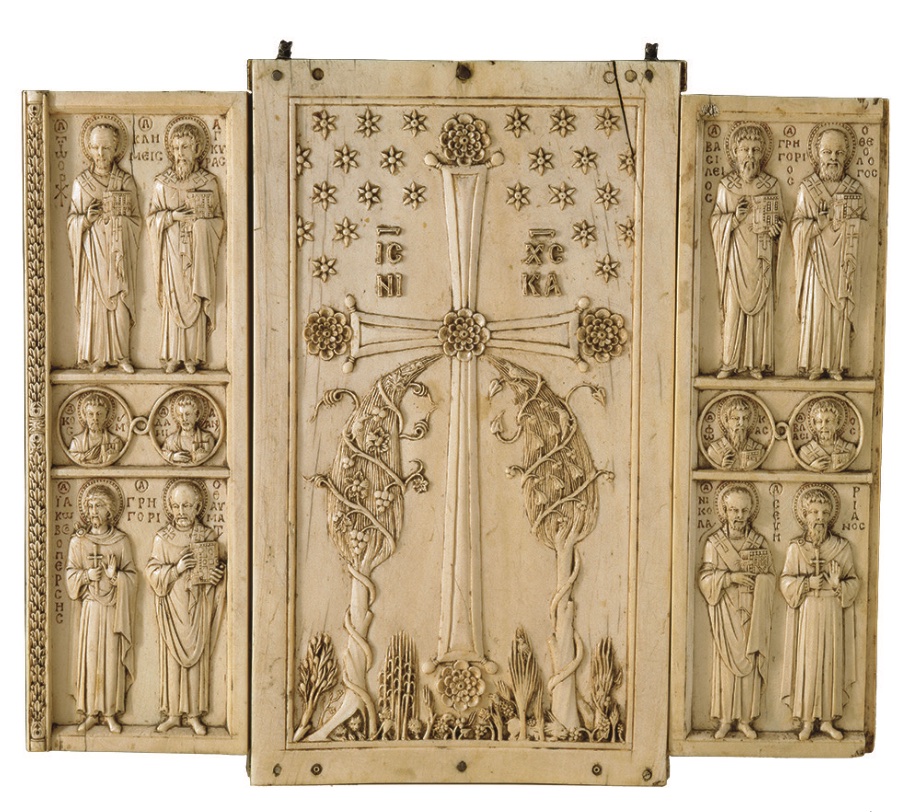
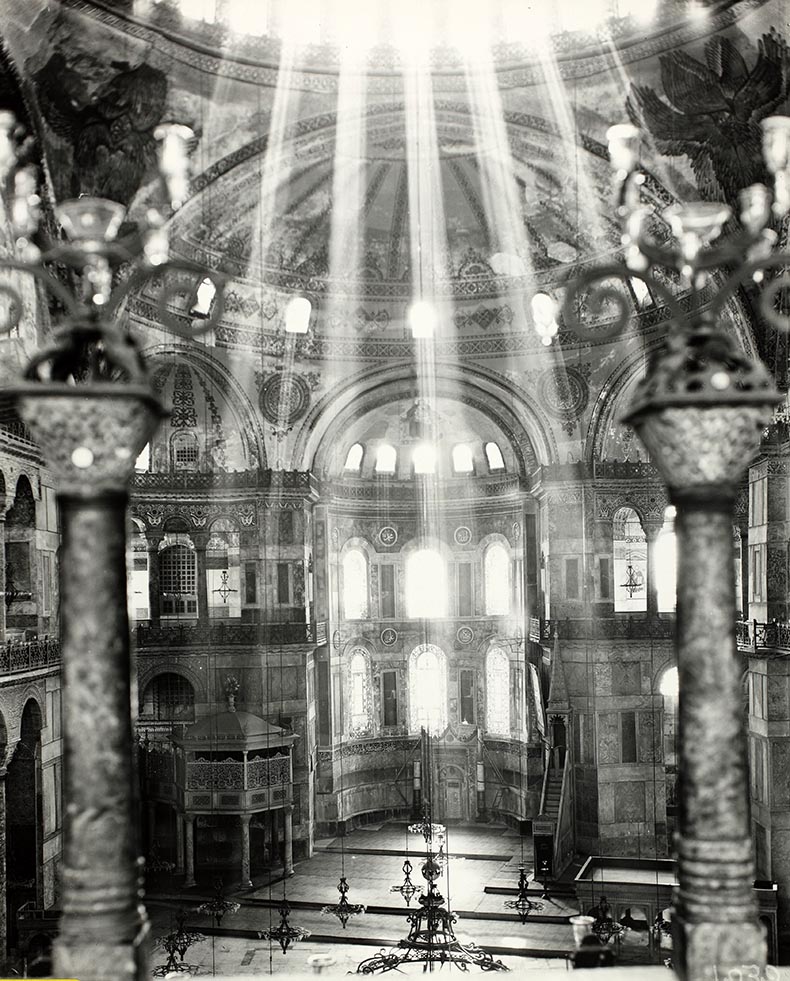

The stone used in the construction mostly came from state-owned quarries. Local green stone was used in the foundations. The bricks, Hagia Sophia was built primarily in brick, were made in and around Constantinople. The foundations of the church are solidly set on bedrock. The distortions in the building are entirely due to mortared brickwork drying and moving about - plus the effect of dozens of serious earthquakes and their repairs.
The marble was gathered from all over the empire. It was transported to Constantinople in huge ships that were operated by private contractors. It was possible to order marble in 'one-stop-shopping' that would deliver stuff right to the worksite all around the Mediterranean Sea. You could order so many columns, capitals and even ready-to-order ambos and altars - everything you needed to outfit a church in marble or granite. There were contractors in Constantinople who could take your order for marble from multiple quarries and then send a ship to pick everything up - from port-to-port and bring it to you. Anything could be done if you had the money to pay for it - like Justinian's Vandal gold.
The 48 huge columns in green Verde Antico marble came from mines in Thessaly in Greece, which were very successfully managed by contractors who leased the quarries, mined them and exported vast quantities of this beautiful stone. The columns vary up to six inches in diameter, which is either due to a decline in quality standards, the lack of a servile workforce or simply a lack of concern for old-fashioned classical norms. It is possible that the decline in standards indicates the end of the use of contractors and the direct involvement of government bureaucrats in production.
These columns were so huge that in later times they were said to have come from the Temple of Artemis in Ephesus. It was inconceivable to the medieval mind that monoliths like this could have be made in 'recent' times (the 6th century). The logistics of moving these from the quarries to the building site - traveling over the seas and then up to the building site from the harbor without damaging them - seem insurmountable to us. In Constantinople they were moved on special roads up to the site, pulled by huge lines of oxen, hundreds of feet long. One can estimate that moving each monolith would have required 100 pairs along with their minders. Besides the bellowing of the oxen and the cries of their tenders, the transport and raising of columns within a city was a noisy affair and could make the ground shake. The arrival, transport and erection of the columns would have attracted large crowds of spectators.
One factor that helped in the export of Verde Antico was the fact transport of columns of any size was made easy across the flat, dried lake bed of Lake Voivoiês to the port of Demetrias. One they arrived in port they had to be loaded and shipped. The Romans had mastered the transportation of 40ft columns from Egypt and the Byzantines were using the same transport technology.
Other columns in the church were made of Troad granite, Granito violetto, marmor Troadense, which comes from Çigri Dâg, Ezine, Canakkale, on the Sea of Marmara, quite close the city and easy to transport over the sea. Columns were also used made of white Proconnesian marble, marmo di Proconneso, which comes from the island of the same name in the Sea of Marmara, 100 miles from Constantinople.
The Red Porphyry columns, porfido rosso antico, eight of them in the exhedra - come from Gebel Dokhan (the ancient Mons Porphyrites), in the Eastern Desert, Egypt. They vary in size. There were other Red Porphyry columns in Hagia Sophia. Four smaller columns were used to support a great marble inscription from 1166 erected by Manuel I in the nave. These were sent in the 16th century to be used in the decoration of the new Süleymaniye Mosque. The quarry halted production in the 5th century, so these columns had to be obtained from existing stock somewhere.
The capitals are all made of Proconnesian marble. They were carved into a roughed out state at the quarry and shipped to the building site where they were finished. The design is so delicate that enormous care must have been given to their movement during the building and finishing of the church. In Byzantine times the background was painted a bright, royal blue and the relief was gilded. In this example below you can still see the blue paint. To learn more about the columns and capitals of Hagia Sophia go here.
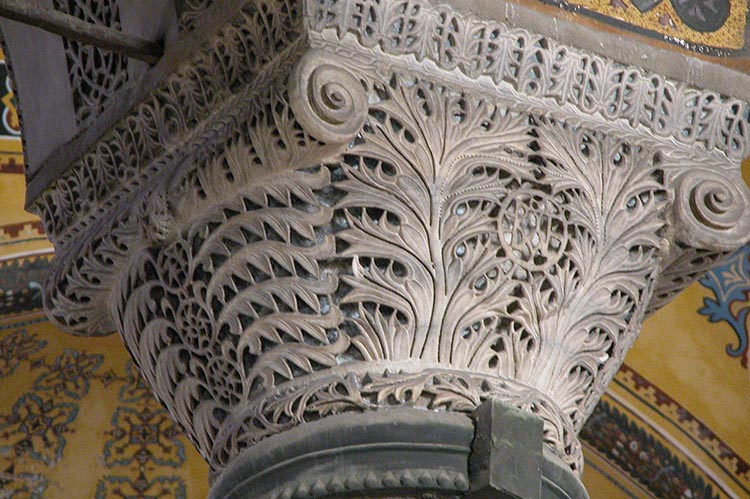
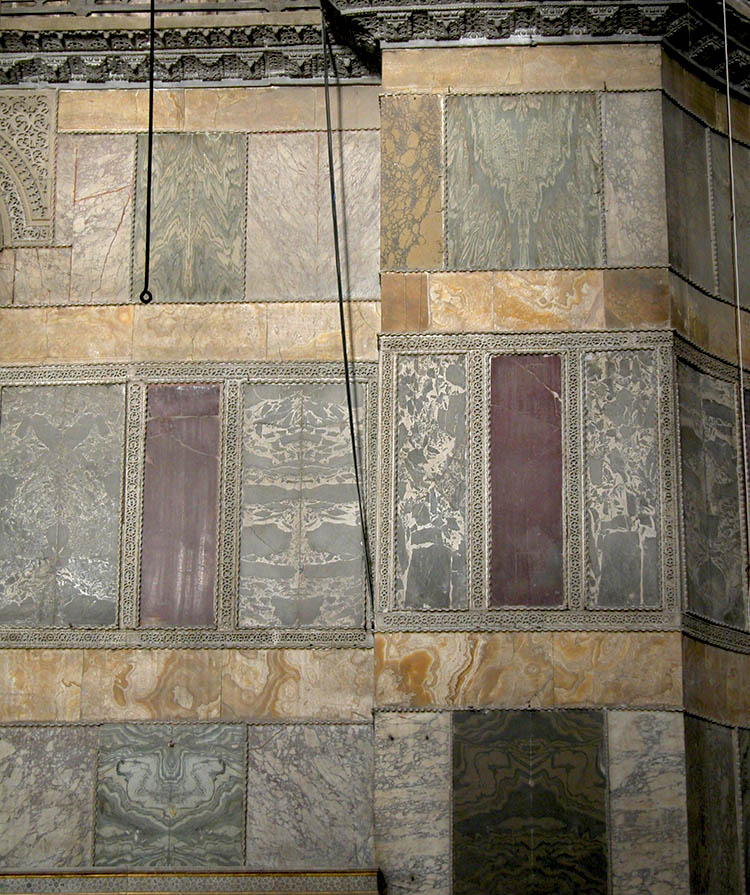 hagia sophia's number one glory - rich and rare marble revetment
hagia sophia's number one glory - rich and rare marble revetmentThe marble revetment of the church - which was assembled from all over the Roman world - was considered the greatest glory of its original decoration. Justinian must have enjoyed receiving beautiful marbles from all over his empire, examining them and making decisions about what would be placed where in the building. Marble blocks were brought to the building site, sawed into panels, polished and then mounted onto the walls with clamps and mortar. Every stone was different and had factors that had an effect on its final form. Some stones were harder than others while others were difficult to polish. Verde Antique is composed of elements that are of different softness; when you polish it it comes out somewhat lumpy. The builders had to wait until the stone and brickwork were fully dry before mounting the revetment. The builders had to make changes to the decoration as they realized they didn't have enough of one stone or another. For example, one finds lots of golden Giallo Antico in the narthex, a stone that barely used elsewhere in the church, they must have run out of it. In fact the bits of yellow Giallo Antico found elsewhere are probably 19th century repairs by the Fossati brothers with marble brought from Italy.
Concerning the marble revetment in the church we can find the green marble of Karystos, rose-colored from Phrygia, red Imperial Porphyry from Egypt, Green Porphyry from Sparta, buff lassikos from Caria, white-yellowish marble from Lydia, gold-colored marble from Libya, chunky black and white breccia Celticum from France, honey-colored Onyx from Pamukkale, green Verde Antique from Thessaly, white marble from Proconnesos and the grey-colored marble from Vosporos, which have all been used. The position of each piece was carefully selected to create patterns and color harmonies. Some sections of revetment have patterns that resemble hanging curtains and others resemble human faces and angels. The mosaics in the arches and vaults were color-keyed to enhance the revetment near it. The huge golden bands of onyx would have echoed the mosaics above.
The revetment has been laid in broad horizontal layers of contrasting colors and patterns, like the striking red cippolino rosso. The contrast with the oceans of plain gold mosaic in the vaults can no longer be appreciated.
One might ask why there are so few colored marbles from North Africa and Italy were used in the decoration of the church. The quarries in those reconquered territories had been long abandoned. Stone from them would have been only found in limited quantities in old stock found in marble yards. The enormous and famous marble yards of Rome could not be tapped because of the constant fighting for control of the city by the Ostrogoths and Byzantine forces. One can also imagine that some of the marbles used in Hagia Sophia were exhausted by the size of the project and were not quarried anymore. It has been claimed that the Byzantines no longer quarried and worked colored marbles after the 6th century. This proved not to be true, we know know the quarries of Chios were reopened in the 11th century to decorate the church of Nea Moni.
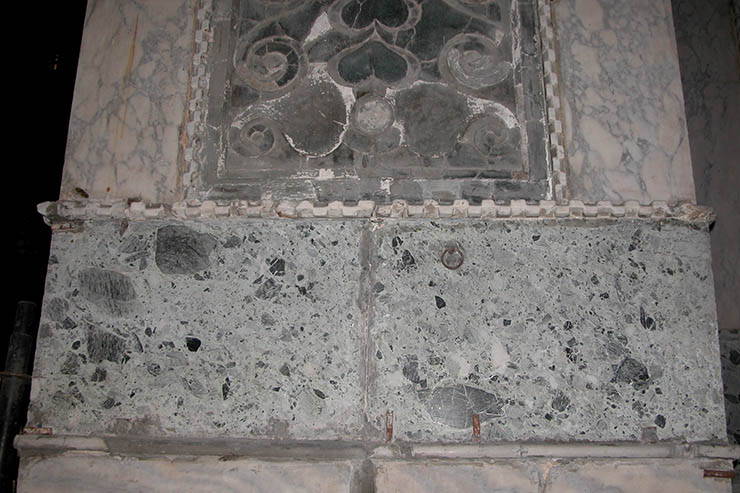
In Hagia Sophia the revetment has been laid in broad horizontal layers of contrasting colors and patterns, like the striking red cippolino rosso. The contrast with the oceans of plain gold mosaic in the vaults can no longer be appreciated. You can learn more about the marble revetment of Hagia Sophia by clicking here.
Over the centuries, some parts of the revetment have degraded and have lost their color. For example some of the panels of Verde Antique (see above) have lost their color, turning gray, and have degraded, in parts, to talc (this has also happened to some of columns of Verde Antique). Due to the physical stress the church has constantly been under since its construction, revetment panels have cracked all over Hagia Sophia and some have become fragmented or fallen down, even in the nave. Panels have been moved from the aisles and galleries to replace these. As a result a significant part of the revetment has been lost in the aisles and has been replaced with painted plaster. It would be easy to replace the missing slabs, many of the quarries can still be worked or are operating today.
Although close to 50% of the revetment in Hagia Sophia has vanished due to its removal to decorate Ottoman palaces and mosques, you would probably be surprised to know that the large parts of the revetment have their original surfaces and have not been cleaned and polished in more than 1,000 years! You can still find the undisturbed history of the church in the layers of oil, grime and candle soot there.
The Byzantine Institute began to polish and clean the revetment starting with the western nave wall in 1958, but the work stopped. Continuing the polishing would remove the gray dusty blanket that covers the revetment and bring out the colors and contrasts that are missing today. If you would like to learn more about the marble revetment and where it came from I have created a special page with 40 images. Click here to see it.
Fortunately the building of Hagia Sophia was early in his reign, before the real horrors began. The problems were not financial they were structural. Being so close to the job site Justinian carefully monitored the construction progress himself and make decisions. His builders, the famous team of Anthemios and Isidorus, encountered many challenges due to the scale of the project and the limits of the building materials used, particularly the drying of the mortar. On could say that the primary building material of Hagia Sophia was not brick, but mortar. The piers and arches moved and stretched apart in odd and uneven directions as it dried. The builders made changes and modifications to the design as it went up, with a great deal of improvisation, arches and buttresses were added, the columns in the upper arcade were increased from 5 to 7, which spoiled the symmetry of the colonnades forever. The superb dome they built - one that seemed to float above the nave - only lasted for 20 years when it came crashing down - destroying $9 million of silver-covered stuff in the sanctuary. The replacement of 563 was taller and less elegant, but was more secure structurally. It took almost as long to rebuild the dome as it took to build the church originally.
Most of the people who worked on the building of Hagia Sophia or who attended the consecration were dead three years later. In 541 the Black Plague hit. 60% of the population of Constantinople died in two years. It was a huge drag on the economy and the morale of the people. A large part of the city was empty, houses were abandoned and the colonnades of public forums and their shops were deserted.
The plague returned to Constantinople six times in only 60 years. Justinian himself became sick, but survived it. The plague was something unique that had never been seen before. In Roman times there had been two outbreaks of measles and smallpox that killed large numbers people, but the population built up a natural resistance to them and they didn't reoccur. Every time the plague hit the people must have thought that they had finally paid for whatever sins they had committed and their suffering must now end. Meanwhile, wars were popping up all over the empire, nothing was really secure. These were dark times. One of the reasons the rebuilding of the dome in 563 took so long was a lack of workers caused by the plague.
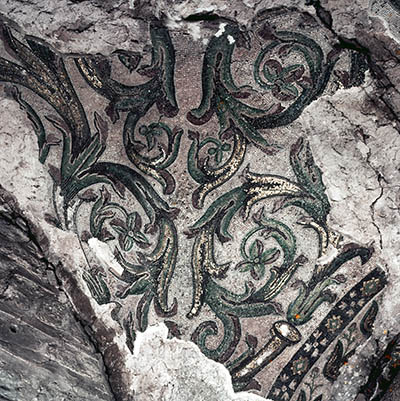
It has been estimated that it took two years to decorate the building with mosaics and they would have required around 200 Roman pounds of gold to make the gold mosaics, which isn't a lot of money. Much of the original work had to be redone when the dome fell. The Byzantines were experts in getting the maximum acreage of mosaic using the least amount of gold. The first mosaic decoration of Hagia Sophia was simple and was limited to eastern-style decorative motifs, acanthus scrolls and crosses. There were no figurative mosaics. Justinian's decorative mosaics are, frankly speaking, ugly and anti-classical. Where did these designs come from? Was Justinian making bad design decisions because he had no taste? Was he experimenting with a new design vocabulary for churches that just didn't come off? Were his contractors making bad decisions that he had to live with? Were they running out of money and cutting corners? The whole Hagia Sophia project pushed the limits of engineering and design and was the dream of Justinian - an autocrat who was used to getting his own way. He did not like explaining things, it was easier just to order something done and move on to the next crisis. We know from San Vitale in Ravenna that Justinian commissioned gorgeous classical mosaics. Although the workmen were local Italians the designs came from Constantinople. After Justinian, in the reign of Justin II, more mosaics were installed in the rooms that connected Hagia Sophia to the Patriarch's Palace on the south side of the church. You can see some of these vault mosaics on the right. These mosaics are in a pure classical style - even Hellenistic - of beautiful bunches of twisted acanthus. What a pleasant contrast to Justinian's irregular palmettes and crude rosettes!
Below you can see restorers working on vault mosaics in the 1930's. This will give you an idea of the scale.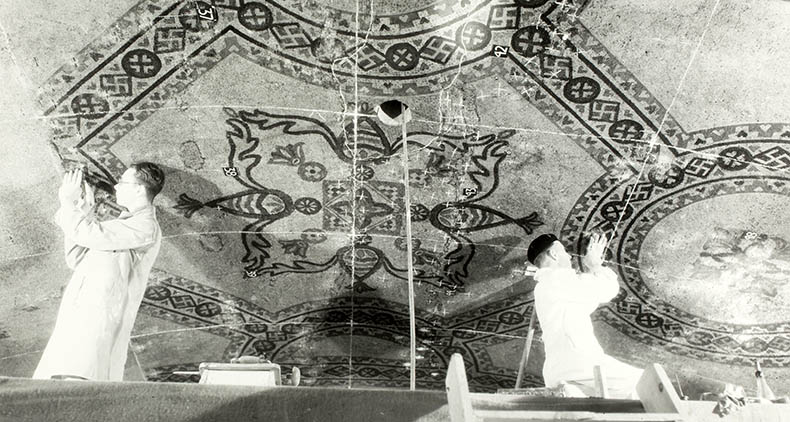 Below you can see a color image from the 1930's showing the vault above the Leo mosaic in the narthex before restoration. Being from the 30's it's not the best image. Parts of the decor and gold vaults have been replaced in paint. The paint is work that was done in 1850. This will help you understand the colors and the effect of the gold.
Below you can see a color image from the 1930's showing the vault above the Leo mosaic in the narthex before restoration. Being from the 30's it's not the best image. Parts of the decor and gold vaults have been replaced in paint. The paint is work that was done in 1850. This will help you understand the colors and the effect of the gold.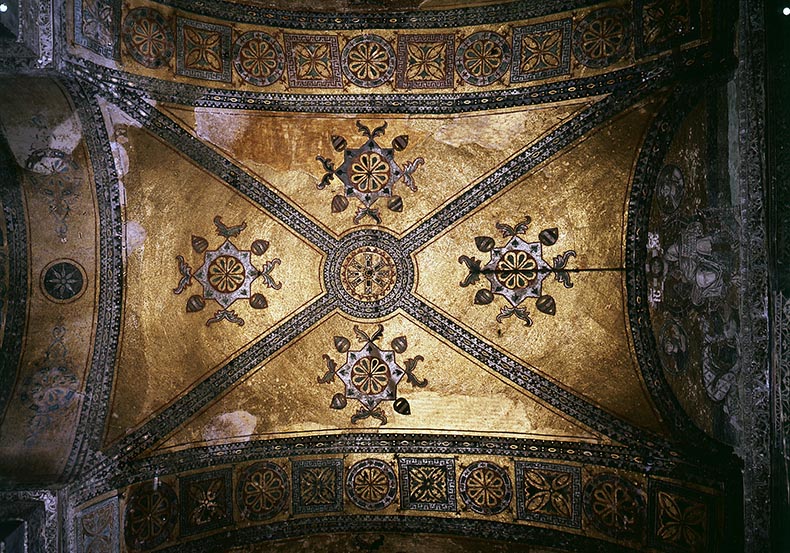
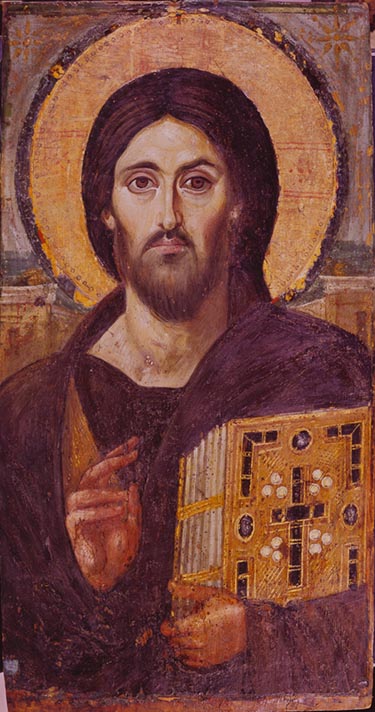 art and icons in hagia sophia in the time of justinian
art and icons in hagia sophia in the time of justinianJustinian would have ordered and installed in Hagia Sophia a compete set of over-sized, realistically painted portrait icons of Christ, His Mother, John the Baptist and other saints. They would have been placed throughout the church at eye level, especially in the nave near the sanctuary. They would have been virtually identical to the icons Justinian delivered to his church in the Monastery of Saint Catherine in Sinai. Like these they would have been painted in heated wax colors on wood panels. Unlike icons in later days, these simple and direct images were not covered with gilded silver, gems and pearls. There purpose would have been to accurately depict their subject matter as they would have appeared in real life. They would have served the same purpose as images of the emperor that were mass produced and sent around the empire since classical times to stand-in for him in Imperial ceremonies. These icons would have remained in the church until the arrival of Iconoclasm in 726.
The image of the famous Christ Pantokrator from Sinai at the right is one of Justinian's gifts.
Throughout Hagia Sophia you can find crosses in mosaic, marble, and bronze. Crosses are the most prominent aspect of the decoration of the church and were placed there to protect the people, the city and the church. There were three crosses and a tree in brick on the outside of the apse that were concealed under plaster and were never meant to be seen. The frightening effects of the darkness of 536 was certainly one of reasons for them. There were more bad things happening. Justinian's reign saw disasters in the city including the Black Plague (which wiped out a third of Constantinople's population in a month) and many terrible earthquakes, even two serious ones during the building in 526 and 527. More earthquakes in 542 and 557 lead to the collapse of the first dome in December 558 mentioned earlier. Besides the huge crosses on the walls and doors hundreds of small ones were inlaid into columns and revetment all over the church. Many of these have been pried out, mutilated or painted over, but they are still there.
Early on there were relics to be seen in the church. In 675, before Iconoclasm, the Gallic bishop Arculf, in the earliest Western account of Hagia Sophia, reported he saw the True Cross on display in the north aisle, where it was kept in a reliquary. It was brought out in its wooden box during Passion Week for veneration. The box was kept on a special table which he describes as an altar, and he says the True Cross was assembled from three pieces of wood. A separate day for veneration was assigned for men on Good Friday, a second day for women, and a third day for the clergy. He says that the chest, when opened to show the cross, put off a beautiful sweet smell.
You can learn more about relics in Constantinople by visiting this page.
During the Persian Wars of Heraclius, in 624, a large part of the silver and gold treasure of Hagia Sophia was turned over to the Imperial mint and struck into coin to pay for troops and supplies. It was a loan that he repaid from loot taken during the successful expulsion of Persians from the eastern provinces of the empire and the final, successful invasion of Persia itself:
"In this year, on April 4, in the tenth indication, immediately after Heraclius had celebrated the festival of Easter, on Monday evening, he moved against the Persian power. He seized the possessions of the blessed houses (churches) in loan, and, impelled by his lack of resources, he even took many candles (gold and silver candle sticks) and other serviceable implements of the Great Church itself, and struck gold coins and very many miliaresia (silver coins)."
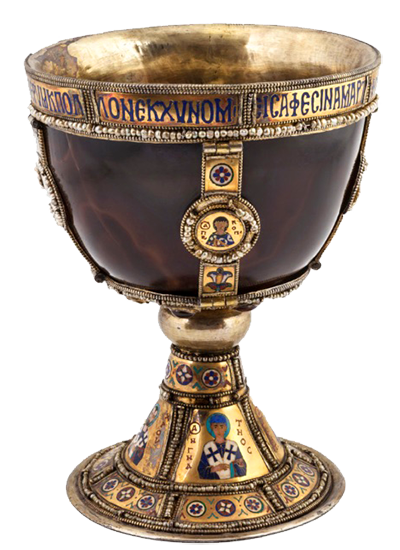 We don't know if he touched the huge silver-plated Royal Doors in the narthex which made of wood from Noah's Ark. There was possibly more silver and gold to be found in Hagia Sophia then anywhere else in the world at the time and it was always a tempting source of funds. Canon law forbade the melting down of sacred church things except to release captives.
We don't know if he touched the huge silver-plated Royal Doors in the narthex which made of wood from Noah's Ark. There was possibly more silver and gold to be found in Hagia Sophia then anywhere else in the world at the time and it was always a tempting source of funds. Canon law forbade the melting down of sacred church things except to release captives.
Due to another earthquake in 869 Basil I made repairs to Hagia Sophia. According to a history of Basil's life and deeds:
"Thus, as the lofty and western arch of the famous divine shrine that has been assigned the name of the Great Wisdom of God had developed grave cracks and was threatening imminent collapse, (Basil) had it tightened and restored with the help of skilled master craftsmen and rendered it sturdy and sound. He also caused the image of the Mother of God carrying in her arms her immaculately conceived Son to be depicted in that arch; and he had Peter and Paul, chiefs among the apostles, placed on either side of her. He also had most generously provided remedies for other wounds in the church, both by construction and subsidy"
These mosaics survived for a thousand years - until at least 1850 when they were last recorded by Saltzenberg. They were scraped off around 1895 during a "restoration" of Hagia Sophia by Ottoman religious authorities.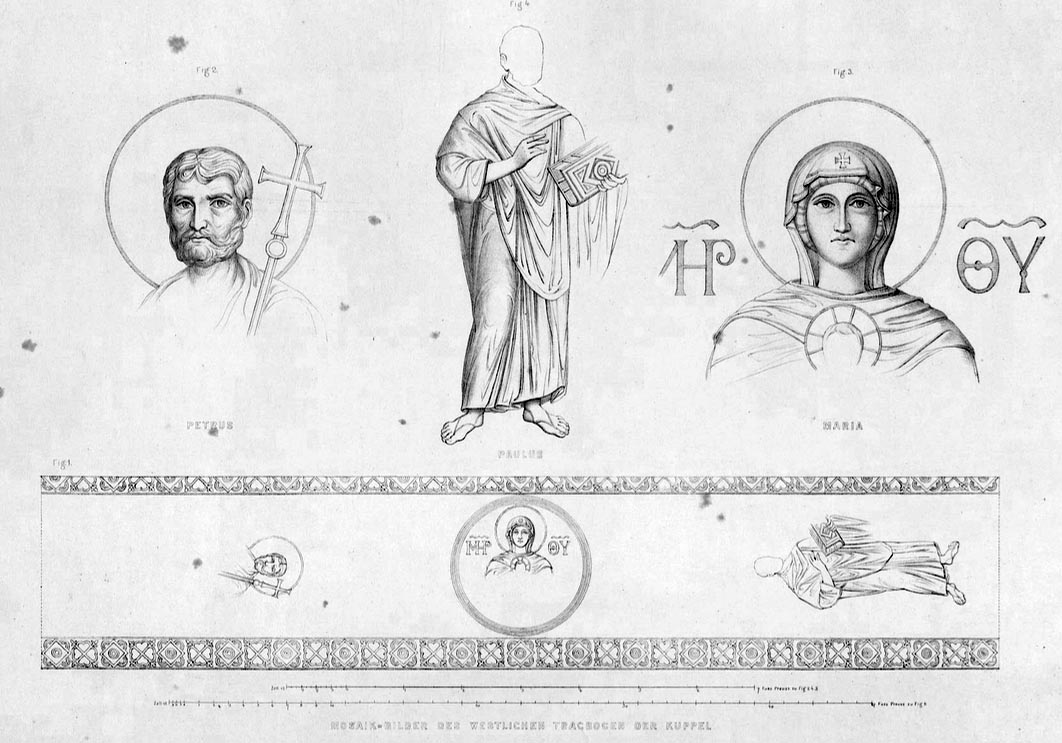
Part of the western dome, arch and semi-dome fell in a powerful earthquake on the eve of the day of Saint Demetrius, October 25, 989. The earthquake damaged the walls of the city and collapsed many of the great houses and apartment blocks of the city, killing many of their their inhabitants. The damage to Hagia Sophia was repaired by the architect, Trdat, who was the chief architect of the Bagratid kings of Armenia. For several hundred years the Armenians had been building enormous stone cathedrals - in basilica, octagon and domed designs. Many of these survive to this day. For many generations the Armenians had served in the Byzantine army as generals and soldiers, the Imperial court had been filled with them and Armenians had married into the ruling dynasties of Byzantium. The Armenian contribution had been immense. It was natural that Basil II would turn to Armenia for the skill and expertise of the best professional architect and engineer he could find to repair the church. Trdat's experience was in building huge stone buildings with stone-block vaults and domes. He seems to have had no experience with brick and mortar construction until he worked on Hagia Sophia. An Armenian historian tells us:
"Even Sophia, the cathedral, was torn to pieces from top to bottom. On account of this, many skillful workers among the Greeks tried repeatedly to reconstruct it. The architect and stonemason Trdat of the Armenians also happened to be there, presented a plan, and with wise understanding prepared a model, and began to undertake the initial construction, so that it was rebuilt more handsomely than before."
The repair work was completed in 994, and it changed the shape of the western semi-dome and width of the western arch. For reasons of economy Trdat salvaged and reused as much of the fallen masonry as he could. This involved used bricks and worked stone from the dome cornice. He used lots of big iron clamps in his repair of the marble cornice; which can still be seen. His repair of the western semi-dome was not entirely a success; its curve was distorted by Trdat's brutish obsession to stabilize the forces that were pushing the western arch apart regardless of the aesthetics. Thus Trdat's work is heavy, he is obviously taking no chances in his repairs failing. The success of his work is proven by the fact it has survived to this day.
I
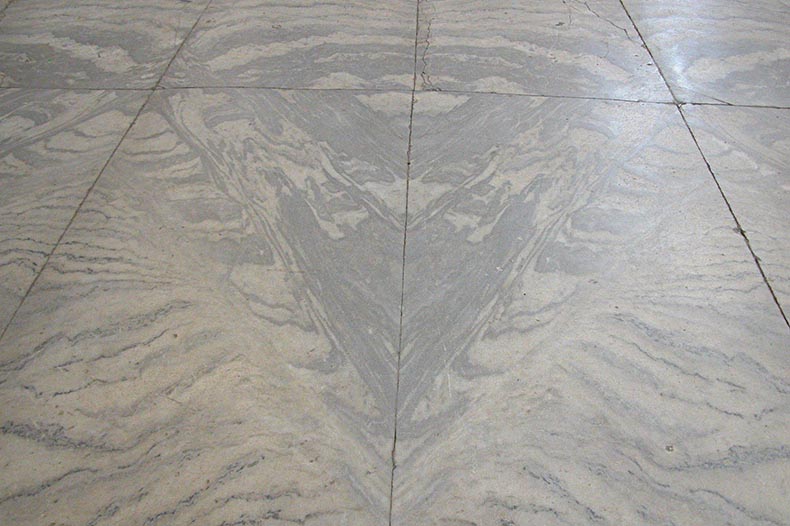 awesome marble floors - walk on stone oceans and green rivers
awesome marble floors - walk on stone oceans and green riversAbove is a picture of the marble floor showing how the patterns were laid down. The white with gray streaks Prokonnesos marble floor of Hagia Sophia we see today was replaced after the first dome collapse, the old floor is still underneath the later one. The slabs face east-west and are around 6 x 4 feet in size. There are five bands in green Thessalian marble set into it. They are called rivers and they are guides to mark things to do as as processions moved through the church to the sanctuary. There is a 18.5 foot opus sectile square with inset marble, granite and porphyry disks surrounded by mosaic bands and inset designs. It is called the Omphalos. The huge 11 foot center disk in gray granite marks the spot were the Emperor would sit during services. It was fenced off from the nave by a bronze railing. Further east the floor is set with huge slabs of colored marbles that mark the position of the altar. If you look at the floor here you can still see the damage caused by the collapse of the eastern part of the dome in 1346.
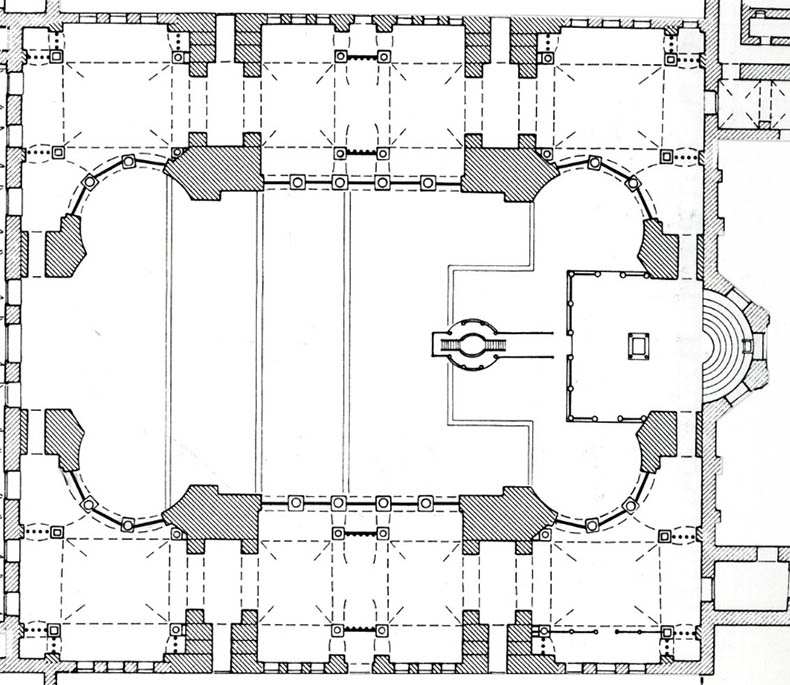 Above is a plan of the nave of Hagia Sophia showing the layout of the sanctuary furnishings, solea and ambo.
Above is a plan of the nave of Hagia Sophia showing the layout of the sanctuary furnishings, solea and ambo.
Hagia Sophia was - and is - justly celebrated for the luxuriousness and opulence of its decoration which included rare and costly marbles, acres of gold mosaic and rich liturgical furnishings. The church has a very long history and enjoyed periods when money and art was slavishly smeared all over the building. An astronomical amount of silver was fashioned into hundreds of candelabra hanging from the dome cornice, the arches between the columns and set on top of the solea and ambo in the nave. There was a huge ciborium rising over over the altar with four silver columns and an eight-sided pyramidal roof also made of silver. I cannot imagine how they kept all of this silver bright and shiny. The altar was plated with silver and gold set with gems. Above it hung a golden dove, symbolic of the Holy Spirit.
The emperor Romanos III 1028-34 had the capitals of all of the columns in Hagia Sophia gilded in a thick gold leaf. There were 5 great gold discs that adorned Hagia Sophia. It the last days of the Empire and Empire sold two of them to replenish the state treasury. One can only speculate on how big they were and is they were still in the church to be looted by the Ottomans in 1453.
There with hundreds of gold and silver chalices, patens, dishes other jewel encrusted tools used in the Eucharist that were sacred and could never be touched or melted down to raise emergency state funds or finance the activities of the church. (Heraclius did not melt down holy consecrated vessels) As more were given to the church their number increased even more. In 1204 when the crusaders looted Constantinople and all her churches, they took 40 chalices from the altar of Hagia Sophia alone. In addition there were sacred reliquaries for relics like the True Cross, the Crown of Thorns, the Mandylion - hundreds, indeed thousands - of relics that were encased in silver, gold and enamel cases that were set with jewels and lined with strands of pearls. Until 1204 every corner of Hagia Sophia had its own shrines and relics. They walls were even set with precious icons and crosses that had been set in the marble revetment. Below you can see an example of the cavity left behind after an inset cross had been pried from the wall of Hagia Sophia. The cross is in the Western Gallery facing the altar. Since then tens of thousands of people have touched the marble and have worn holes through it. The hand gives you an idea of the size of the cross. There are five of these crosses inserted in the revetment of the Western Gallery. They are easy to find.
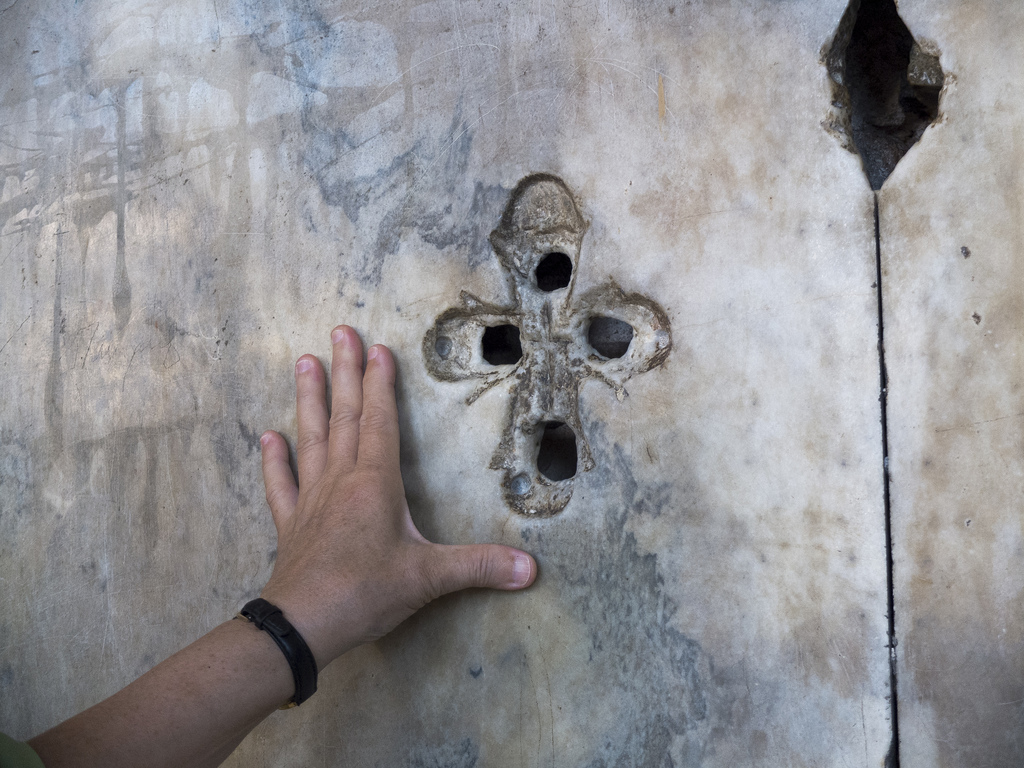
These crosses are set into the bases of columns and are inset into walls. The crosses on column bases are all on the ground floor of the church and are placed only on the bases of porphyry columns in the exedra facing east. The cases of the columns are higher than other bases in the nave and could be kissed. The porphyry columns of Hagia Sophia were always singled out for special attention by pilgrims. Those in the northwest bay were thought to be the location of miraculous cures. There is another cross inserted into the revetment of the nave closest to altar, just to left of the curve of the porphyry columns. Relics were attached to all of the columns of Hagia Sophia above their capitals. All of the crosses inserted into the walls are at the same height so they could be kissed by the faithful, around 55 inches. Two of the crosses are in the north part of the narthex between the doors marking the spot where pilgrims entered the nave of Hagia Sophia. You can look for these in the green band of marble, the third one from the floor. Pilgrims would kiss these crosses before entering. We don't know the date of any of the crosses, but they must all be post-iconoclasm.
The church was full of the most important artistic treasures of Byzantium, too. The chancel screen and the solea were decorated with beautiful icons that were unmatched in their artistry and holiness. The most talented artists were invited to decorate Hagia Sophia with paintings, mosaic and even sculpture both inside and out. We will never be able to fully appreciate the artistic heights Byzantine artists achieved, since almost everything has been lost to looters and religious zealots who hated art and beauty so much that they had to destroy it. We are fortunate that a very small part of the mosaics of Hagia Sophia have survived and that the Deesis - perhaps the greatest expression of Byzantine art ever created, has come down to us.
In the 12th century Hagia Sophia had a staff of deacons and clergy of 500. In the early part of the century Alexis Comnenus as a cost saving effort had reduced the paid clergy from 700. They were highly trained in the Greek language and the teaching of theology, which involved study of the gospels and preaching. They were also responsible for the celebration of the liturgy and broadcasting news of the Imperial court and current events in the city and around the world. When the Emperor was on a military campaign he would send the official Imperial newsletter to the clergy and deacons to be read from the ambo in the center of the church. The clergy was very concerned with the correct form and pronunciation of Greek and was responsible for setting the official form of Greek throughout the empire. When Alexis I Comnenus reduced the paid clergy of Hagia Sophia this pushed out the excess staff out to provincial churches where they raised the educational level of the local schools. Here they taught reading and writing. In the local schools students learned large parts of the Bible by heart. Everyone learned the Creed by heart at a young age. The clergy of Hagia Sophia was also responsible to teach Byzantine Christian theology and they set the curricula that was used throughout the rest of the empire.
Every member of the clergy of Hagia Sophia would have aspired to possess his own personal library. It would have been essential for him to have his own gospels and other books for personal study and private devotion. He may have secular books, too, like histories, apothecaries and textbooks for teaching. All of the deacons and clergy of Hagia Sophia were highly literate and carried on correspondence with friends, family and colleagues. They could copy books for their own use and as gifts to others. Hagia Sophia had its own semi-public library with hundreds of books or all sorts. The church also had a vast number of books that were used in services held in the church. There was also a vast archive of millions of documents on file relating to the church and the Patriarchate along with a staff of archivists who knew were everything was. The massive Imperial archive of Constantinople was stored in the great vaults of the Hippodrome, Hagia Sophia would have had its own archive somewhere close to the church. Over his years of service a clergyman could amass a substantial library of books, correspondence and assorted bits copied from many sources.
The clergy of Hagia Sophia were paid once a year in an official Easter-time ceremony in the South Gallery. They were given sacks of gold coins that were marked with their name, the amount they contained, that were tied with red silk cords and carried red wax Imperial seals. Since Orthodox clergy can marry they lived with their families near the cathedral. Besides the clergy and deacons there with more than 4,000 support staff who maintained the building and managed the crowds of local worshipers and foreign pilgrims. Hagia Sophia was truly the "Great Church" and the number one religious institution in the empire. Its influence spread everywhere through the standards it set in theology, art and music. There were many staff attached to the church who spoke foreign languages. They came from many ethnic backgrounds. In the 12th century Constantinople saw a huge rise in population, which not only included Greeks but also was made up of Hungarians, Serbians, Italians, Turks, Russians and other nationalities. Second generations could rise to top church jobs, even the Patriarchate itself.
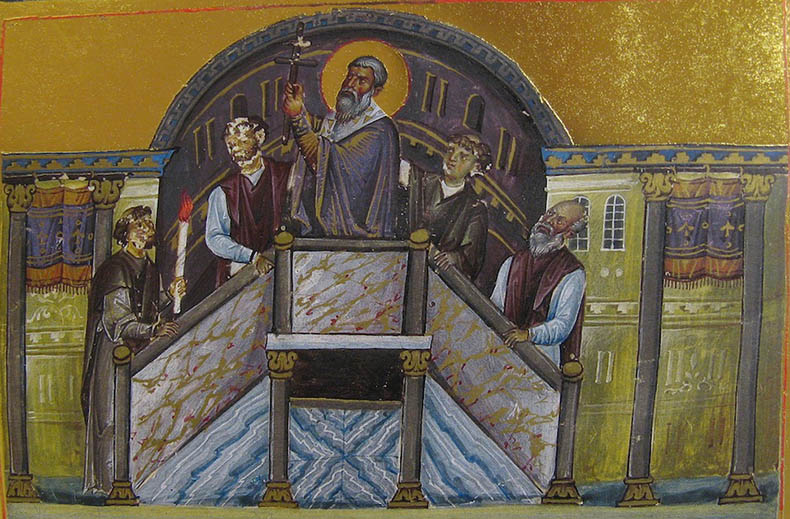 a massive commercial enterprise staffed with eunuchs
a massive commercial enterprise staffed with eunuchsThe clergy and staff of Hagia Sophia was fed from the wide-spread estates owned by the Great Church. They produced grain, wine, vegetables, oil - everything that was needed to supply the refectories attached to Hagia Sophia. The church controlled all aspects of food production from harvest, transport, grinding of grain and finally the baking of its own bread and its final distribution. A large part of bread production was meant for the poor and aged in Constantinople while the rest went to bakery shops run by the church. Private bakers bought and milled their own grain. The Bread Market and Baker's Quarter was called the Artopoleia and was located somewhat to the south of Kapalicarsi in modern Istanbul. We don't know if bread makers and bread sellers operated from the same shops. The Byzantines used honey with their bread and consumed enormous quantities of it. The Imperial government encouraged the import of both honey and wax to Constantinople, the top exporters were Russia and Bulgaria. Besides honey in the Artopoleia you could also buy wine, fish and cheese. Outside of shops food and drink was sold in taverns and by street vendors.
One aspect of Byzantine clergy that would seem odd to us today was the number of eunuchs. There were no impediments to eunuchs serving through the church hierarchy. They also were an established part of the cathedral choir in this period. Women also served in Hagia Sophia and there were celebrated female choirs there.
The late 12th century was a period of great political turmoil in Hagia Sophia. The center of the city, where the church was located, was the central agora of Constantinople where the great colonnades and streets and squares of rows of shops and inns crossed. Crowds of 50,000 could easily assemble in a few hours in response to rumors or appeals for public intervention or to protect fugitives. Hagia Sophia was right in the middle of this. There were a large number of guards assigned to protect the church, but these were ineffective in response to such huge numbers of people. Once a mob got into the church it was virtually impossible to get them out. Usurpers headed to Hagia Sophia both to claim the throne and to avoid the wrath of the sitting emperor if their rebellion failed.
In 1180 the Porphyrogenita - daughter of Manuel I - Maria Komnene and her husband, the Caesar Renier of Montferrat, revolted against Manuel's second wife, Maria of Antioch, who became regent after his death, The Porphyrogenita Maria may have considered herself the rightful heir, as the elder child of Manuel; she was almost as old as her stepmother Maria. Maria and Renier gained the support of the Patriarch Theodosius I and used Hagia Sophia as a base of military operations. Alexios, Manuel's son by Maria and the recognized heir, had the patriarch arrested, leading to open warfare on the streets of Constantinople. Buildings around Hagia Sophia were demolished to allow for the movement of troops and fires threatened the church with destruction. Troops were climbing all over the ancient monuments in the city center and raining down missiles on their opponents below in the Augusteon. It was a touch and go situation. It didn't help that Maria's troops included many foreigners who were indifferent to the history and sanctity of Hagia Sophia. In this case there was a peaceful resolution to the conflict and troops were withdrawn.
Just 23 years later, in 1203, Dandalo, the blind doge, of Venice diverted the Fourth Crusade to lay siege and sack the city of Zara on the coast of Dalmatia to cover the costs of their passage on Venetian ships to the Holy Land. Then, with the blessing of the pope, Innocent II, they were diverted against to Constantinople to place an overthrown Byzantine emperor, back on his throne for a huge ransom. Once they arrived Alexis was unable to pay the money he had promised. The amount he owed kept growing as the crusaders upped the amount. The Pope and the Catholic bishops who were with the crusaders told them that they could loot and destroy the city and its population because they were degenerate heretics. The crusaders, who called themselves pilgrims not soldiers, decided to loot the city. One of their schemes was to drive the population from the city through terror. They set fires in the most densely populated neighborhoods of the city to drive the poor out. They felt they didn't have enough troops to conquer and control Constantinople so they would reduce the population. The fires were set to protect the rich neighborhoods so they could be looted. The Venetian Quarter was intentionally left undamaged. The fires destroyed more than a third of the city. The palaces of Blachernae and Bukoleon were spared to be turned over to the victors. The beautiful classical forums and colonnaded streets were enveloped in flames, the fires spread to churches, palaces, fine homes and tenements. The finest city in the world was burning right in front of the crusaders. The justified the destruction because it had been blessed by the pope and his clergy. They were really excited at the thought of the riches that would soon be theirs.
The city was then taken by assault and surrendered. The French crusaders then drove hundreds of thousands of terrified people through the streets, strip searching them for valuables. They wanted everything left behind in peoples homes and in the churches so they could loot the city at leisure and maximize their treasure. Most of the people were expelled from the city, driven into the countryside with nothing, some even without clothes. Besides treasure the bishops, priests and monks of the crusade conducted their own sack of the city looking for relics and other holy things. Some were too ashamed to do it themselves and hired soldiers to terrorize priests, monks and nuns into turning over their relics. This took place on Palm Sunday, it was hell on earth for the Christians of Constantinople at the hands of the French Catholic Crusaders.
Hagia Sophia, one of the chief prizes to be sacked by the crusaders, was sealed off and subjected to a meticulous stripping of all of its treasures. Donkeys were brought into the church to carry stuff off, some resisted the crusaders who killed the poor animals and spread their blood all over the marble floors. Prostitutes were brought into the church, who were lifted onto the altar, and encouraged to sing songs with filthy lyrics. One can assume that the crusaders took advantage of the women sexually right there in the sanctuary. The Venetians had made a list and pre-planned their looting so they got to the most precious things first, like golden chalices, icons, gospel covers and patens set with gems, pearls and gold enamel. Much of the loot in Hagia Sophia - like the great altar and silver ciborium - was too heavy to immediately break-up and add to the spoils. It took months to dismantle everything and melt it down into ingots. Like locusts the crusaders swarmed through the church every nook and cranny of Hagia Sophia looking for more. The French soldiers had no interest in the works of art in the church and broke icons up to remove their silver covers. They ripped the silver covers off of books of the Gospels and tossed aside their illuminated manuscripts into heaps of trash. Finally, having taken everything they could at ground level they turned their attention to the golden crosses and crowns that had been suspended in the sanctuary for centuries. Some of the crosses were huge, larger than a man and hanging by silver chains. They were grabbed by hooks, pulled down and added to the pile of loot. Priests and old church wardens were tortured into revealing anything of the smallest value. The greed of the crusaders was insatiable. You can learn more about the looting of the sanctuary by clicking here.
The Latin crusaders turned Hagia Sophia into a Catholic church, installed their own clergy and crowned their own emperor. They occupied the Patriarchal Palace and ejected any Greeks they found there. The city and the empire was divided up among the leaders of the crusade. The Venetians got Hagia Sophia. They appointed a new Latin Catholic patriarch who established this throne in the former palace of the Patriarch, which had been looted but not badly damaged in the sack of the city. The pope had a hard time finding a candidate both the French and Venetians would accept, and then getting him from Italy to his new see in Constantinople in 1207. The local Greek population of the city stayed away from Hagia Sophia during the time of the Latin occupation. There were very few worshipers and they all came from the French crusaders and Italian merchants. There were armed battles inside Hagia Sophia between the French and Venetians over control of the church. In 1206 the Venetians stole the famous Hodegetria icon of the Theotokos from Hagia Sophia and carried it off to the headquarters of the Venetian Commune in Constantinople, the former monastery of the Pantokrator, which they had converted into an armed fortress. During Latin rule, Hagia Sophia was seldom open, only for special services that served the court of the new empire. Daily Orthodox liturgy ended in 1204 for obvious reasons. There was no money for anything, all of the silver chandeliers that had lit the church were melted down. There was no way to light the church for vespers with no oil for the lamps so evening and night vigils were stopped. Only a few candles were used in the vast church, those brought by pilgrims or the Greeks still left in the city. On the orders of the Pope the Venetians brought used marble columns into Hagia Sophia from the nearby ruined church of Saint Anastasia to create a Latin altar because they had melted down the solid silver columns of the ciborium and broken up the jeweled altar. The Latins melted down almost all of the Greek and Roman statues in the city, many of these were the famous works of the greatest artists of their times. The famous horses of San Marco were taken from the hippodrome and shipped to Venice, a long with hordes of marble columns, capitals and marble revetment. The Latin emperors also stripped the palaces and churches of the city of their lead roofs, which soon caused the collapse of those buildings. In 1217 the stripping of lead and copper from churches in occupied Constantinople was denounced by the Latin Legate from the Pope in Rome, Pelagius. This did not stop the new Latin Patriarch in Hagia Sophia from doing just that on two occasions - in 1221 and 1222. The Latins also removed valuable things like the gold-enameled templon of the south Church of the Pantokrator, which was decorated with semi-precious stone and rare marble. Its parts where shipped to Venice. The Venetians, who occupied the complex of Comnenian churches and monastery buildings, replaced it with a new templon with white marble bits taken from the now ruined church of Saint Polyeuktos. The Venetians dispatched shiploads of stuff from Saint Polyeuktos to decorate the inside and outside of San Marco.
The Latin emperors pawned the relics of the city to the Venetians for loans who then sold them to the French king, who in turn built Sainte-Chapelle to house them. The Venetians soon learned that once they had looted the city of all its treasures they had destroyed the empire and the most important market for their merchants was gone. At first they saw Hagia Sophia as a splendid war trophy but then they had the responsibility of maintaining it. Plus they had the burden and expense of running all the churches of the city along with the Greeks who remained behind in the city. The French Crusaders and the Venetians fought over control of the church for years after they took it. The Pope of Rome, who had blessed the crusade, was constantly called upon to intervene in their quarrels over the spoils.
In 1261 Byzantine troops foraging near the city walls found the city unguarded and recaptured it almost by accident. There was a tremendous uproar in the city as they moved to reoccupy it. Thus, the last Latin emperor was awakened in his bed at Blachernae palace and told Greek troops were in the city and on the way to capture him. In a panic, he fled the palace leaving his bed unmade and the crown behind. He escaped on a Italian ship. Panic spread - the Italian merchants and catholic clergy in the city gathered up what they could carry, forced their way onto other Venetian boats in the harbor and evacuated the city. They left behind anyone who could not afford the bribes demanded by ship captains to buy an escape. Byzantine mobs stormed the Venetian quarter, burning their homes and businesses in revenge for 1204. Many people suffered for those sins of 1204 including people who had collaborated with the Latins and families of mixed marriages.
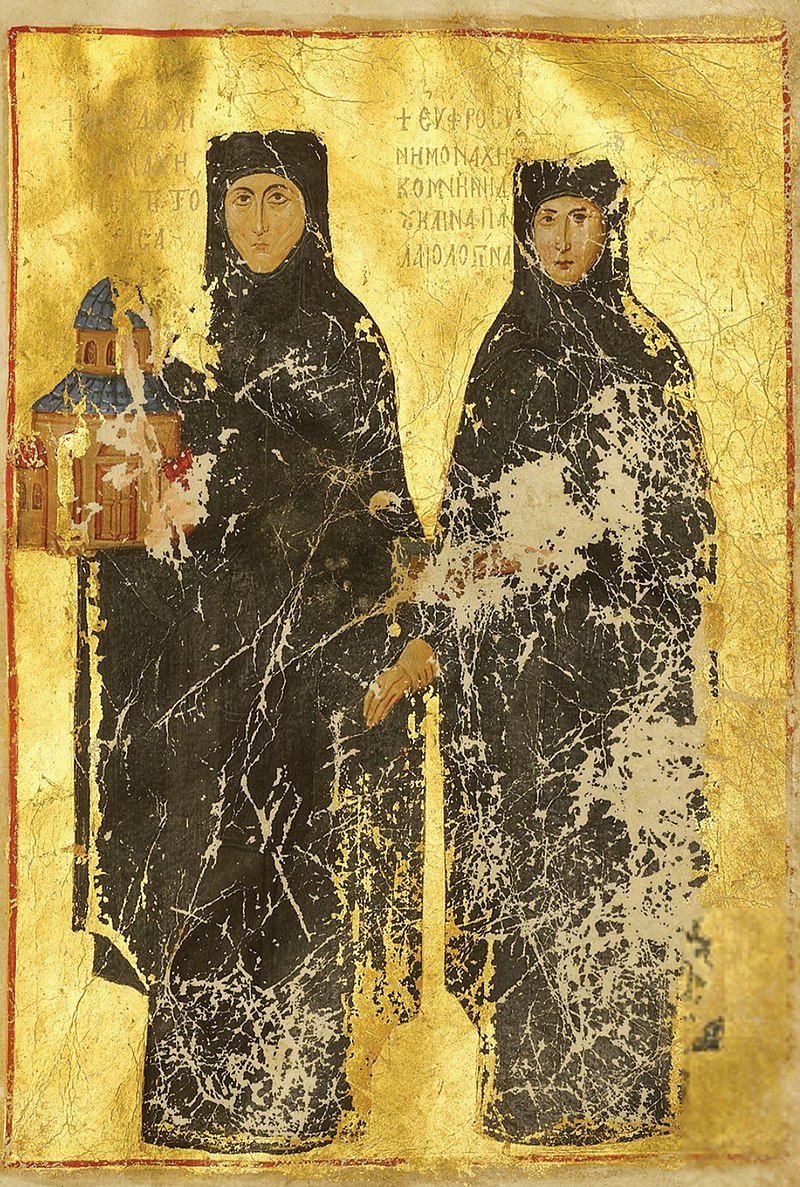 Byzantine officials then restored Hagia Sophia as a Orthodox church to wild rejoicing. Work started immediately to prepare the church for the coronation of emperor Michael VIII. The ambo, solea, chancel barrier and ciborium had to be reorganized and restored. There was no money to recreate the silver sanctuary that was there before 1204, everything was simple and inexpensive. A huge silver lamp bracket was mounted on the top of the chancel screen to illuminate all of the new icons that were set up below. Liturgical vestments and sacred vessels were brought from Nicaea to be used in the church. Candelabra were found to light the altar. Some sacred things thought to have been lost, like the great icon of the Hodegetria, were rediscovered or brought out from hiding. Others were donated by Orthodox princes. The main objective of the church was to reestablish the liturgical calendar in the church and reassemble the clergy and deacons to run it. The pilgrims returned almost immediately and this helped the finances of the church through the donations that came in with them. The church also needed to restore the commercial ties that bound the estates of Hagia Sophia to it because It was soon discovered that it would not be possible to rely on the emperor to support the church as he did formerly. The candle factories and their retail stores were reestablished nearby and the charities of Hagia Sophia the poor relied reopening. The daily distribution of free bread started again alongside the fountain in the atrium. The hospitals and old folks homes that had been attached to the church were opened again
Byzantine officials then restored Hagia Sophia as a Orthodox church to wild rejoicing. Work started immediately to prepare the church for the coronation of emperor Michael VIII. The ambo, solea, chancel barrier and ciborium had to be reorganized and restored. There was no money to recreate the silver sanctuary that was there before 1204, everything was simple and inexpensive. A huge silver lamp bracket was mounted on the top of the chancel screen to illuminate all of the new icons that were set up below. Liturgical vestments and sacred vessels were brought from Nicaea to be used in the church. Candelabra were found to light the altar. Some sacred things thought to have been lost, like the great icon of the Hodegetria, were rediscovered or brought out from hiding. Others were donated by Orthodox princes. The main objective of the church was to reestablish the liturgical calendar in the church and reassemble the clergy and deacons to run it. The pilgrims returned almost immediately and this helped the finances of the church through the donations that came in with them. The church also needed to restore the commercial ties that bound the estates of Hagia Sophia to it because It was soon discovered that it would not be possible to rely on the emperor to support the church as he did formerly. The candle factories and their retail stores were reestablished nearby and the charities of Hagia Sophia the poor relied reopening. The daily distribution of free bread started again alongside the fountain in the atrium. The hospitals and old folks homes that had been attached to the church were opened again
Hagia Sophia tried to reestablished its ties to its traditional sister churches in the city, like the nearby Theotokos of the Chalkoprateion. This was a great burden on the finances of the church as many of these churches were in a semi-ruinous condition. Their wooden roofs were in great danger of fires and their fragile vaults precariously awaited the next earthquake. Some of them had to be abandoned or demolished.
In 1320 a survey of the building indicated the north and east sides of the church were in danger of collapse. Andronikos II commissioned the repairs, and the historian Gregoras says that he paid for them out of a portion of the estate of the empress Irene, who died in 1317 and was buried in the Pantokrator Monastery. Immense buttresses were erected - called pyramids - against the church to stabilize it. They were built by cheap refugee labor, the city was filled with unemployed Greek Christians who had fled the Turkish conquest of the remaining Byzantine possessions in western Asia Minor. The building of the buttresses involved the transport of vast amounts of stone from a number of Byzantine churches that were either in ruin or about to collapse. The famous ancient churches of St. Menas and the Holy Martyrs were demolished. You can see the eastern buttresses below. One effect of these buttresses was the huge reduction of light in the church. These buttresses have never been investigated fully, who knows what could found in them. They must be built of stone-faced with rubble cores. The stone is most likely Proconnesian marble. Andronikos wanted to do more work in Hagia Sophia but was prevented from doing so by the insane civil wars of the 14th century.
The buttresses were built over and replaced the famous chapel-passageway of Saint Nicholas that ran across the back of Hagia Sophia just east of the apse. It is possible parts of this passage were embedded into the buttresses and survive. There were also homes and businesses here that were demolished. A major street ran right across the back of the church.
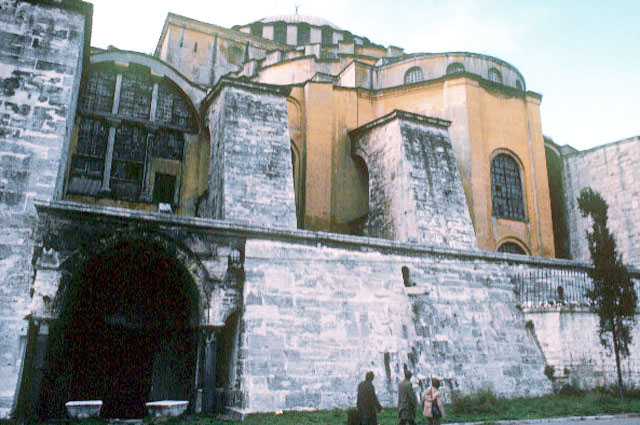
The last collapse of the eastern part of the dome and great eastern arch was in 1346 and has been mentioned earlier. Beginning in mid-October, after a series of earthquakes in 1343, a fissure opened up in the eastern vaults and the great arch began to sag, which resulted in bricks and mosaic cubes raining into the sanctuary; no repairs were initiated and the vaults collapsed on their own 3 years later in 1346. This collapse down a large part of the pendentives, the eastern arch and part of the dome. The new buttresses were, obviously, ineffective in preventing the collapse. One account of the the time described the damage:
"On Friday night, 19 May 6854 [1346], during the reign of Anna Palaiologina and her son, John [V] Palaiologos, when John Aprenos was patriarch, the eastern part of the church of St. Sophia (i.e., the one apse, the third of the dome, etc.) collapsed and destroyed the beautiful ambo, the iconostasis, and all the holy icons. And on Friday 6 October 6855 [1346], the reconstruction of the semi-dome together with the arch was completed."
From this report we are told the columned altar screen, the ambo and all of the icons there were destroyed. We don't know how much of the great sanctuary colonnade collapsed. That would have been very difficult to replace or repair, but we hear no more of it and what was done to restore it. The writer has not said anything about the great altar, so it must not have been damaged. Repairs started right away and, as the account states, were largely complete 4 months later so the church could be reopened for worship and to admit the thousands of pilgrims who came everyday. However, the Black Death struck Constantinople again in 1347 and took away half of the population of the city right in the middle of the repairs. Also, Byzantium was in the midst of horrible - and useless - civil wars. Although money had been raised abroad, more money needed to be raised to finish the repair of the dome and the mosaics. The people of Constantinople were taxed for the repairs and the new mosaics which were finished sometime after 1355. The mosaics were done in two phases are were supervised by an Italian, Giovanni Peralta, and involved a naturalized Catalan named Georgios Astras and a Greek, the the Protostrator Phakeolatos. Phakeoltos, who was described as a wealthy but not well-respected man by his contemporaries, had previously been appointed by the regent Anna to conduct a naval expedition in the in the Aegean. Later he conducted various engineering tasks for the Emperor John Kantakouzenos to build up and equip the navy, which failed completely in 1348. It is apparent that he had come by money through contracting government contracting jobs like the repair of Hagia Sophia. He had his hand in many pots. Astras and Peralta are described as being the technical experts on the project who eventually took on complete responsibility to finish it. The work of restoration was done fast and cheaply. Peralta was closely associated with Kantakouzenos and when he fell from power he disappears, Peralta had lost his patron. Astras continued to take on projects in Constantinople for many years afterwards.
Despite the obvious economies in construction the mosaics in the arch and the two seraphims are very well executed. The mosaic of the Pantokrator in the summit of the dome would have been set in the same style and quality. These figures were huge - the faces of the seraphim are 4 feet across. One of the economies in the mosaics was due to the low supply of colored and gold glass cubes. In these mosaics the cubes are widely spaced to make them go farther. The mosaics on the dome walls are badly done, obviously due to the lack of funds. The decision was made to finish them in this way because this part of the dome was out of sight from the floor of the church. In 12 arches of the dome windows a fresco pattern was substituted for gold mosaic. The loss of reflective surface reduced the amount of light reflected into the interior of the church. It was the ultimate cost-cutting decision, even though gold mosaic is not that expensive. Many of the gold tesserae used in the 14th century dome restoration have chipped edges which proves they are reused. Interestingly, the strange bulge in the pendentive and dome cornice was not the result of this bad repair job. The 14th century masons exactly duplicated what was there before. The great Byzantine scholar and leading authority on Hagia Sophia, Natalia Terteriatnikov, has noted that despite the bad workmanship and poor materials used in 14th century restoration it has lasted for 600 years! How many earthquakes has it endured since then?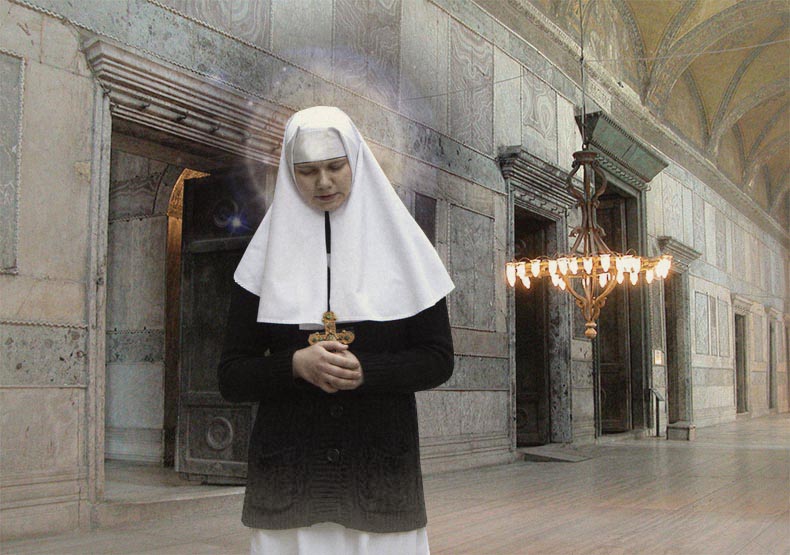
One of the last accounts of a western visitor to Hagia Sophia is that of the Castilian traveler, Petro Tafur, in 1437. he tells us that the building was in splendid condition - as if it had just been constructed. He visited the church immediately after the repairs after the earthquake. From this account we are told the mosaic of the Pantokrator was already completed in the dome. Tefur also tells us that the church was surrounded by beautiful squares and colonnades that were disfigured by taverns and restaurants. He writes:
"On the day following I went to the Despot (Constantine XI, the last Emperor of Byzantium, killed in 1453 defending the city from the Turks), and asked him if he would be pleased to direct that I should be shown the church of St. Sophia and its relics, and he replied that he would do it with pleasure, and that he himself desired to go there to hear Mass, as did also the Empress and her brother, the real Emperor of Trebizond.
We then went to the church to Mass, and afterwards they caused the church to be shown to me. It is very large and they say that in the days of the prosperity of Constantinople there were in it six thousand clergy. Inside, the circuit is for the most part badly kept, but the church itself is in such fine state that it seems to-day to have only just been finished. It is made in the Greek manner with many lofty chapels, roofed with lead, and inside there is a profusion of mosaic work to a spear's length from the ground. This mosaic work is so fine that not even a brush could attempt to better it. Below are very delicate stones, intermixed with marble, porphyry, and jasper, very richly worked The floor is made of great stones; most delicately cut, which are very magnificent. In the center of these chapels is the principal one which is very large; the height is such that it is difficult to believe that cement can hold it together. In this chapel there is similar mosaic work, with a figure of God the Father in the center. From below it looks the size of an ordinary man, but they say that the foot is as long as a spear, and from eye to eye the distance is many spans in length.
Here is the great altar, and here one can see all the grace and richness appertaining to geometry. Beneath this chapel there is a great cistern which, they say, could contain a ship of 3000 botas in full sail, the breadth, height and depth of water being all sufficient. I know not if such a statement can be supported, but I never saw a larger in my life and do not believe that one exists.
The Despot and the others directed the clergy to bring out the holy relics. The Despot keeps one key, and the Patriarch of Constantinople, who was there, the other. The third is kept by the Prior of the church. The clergy, in their vestments, brought out the relics in procession, which were: Firstly the lance which pierced Our Lord's side, a marvelous relic; the coat without a seam, which must at one time have been violet, but which had now grown grey with age; one of the nails; and some thorns from Our Lord's crown, with many others, such as the wood of the Cross, and the pillar at which Our Lord was scourged. There were also several things of Our Blessed Lady the Virgin, and the gridiron on which St. Lawrence was roasted, and many other relics which St. Helena took when she was at Jerusalem and carried here, which are much reverenced and closely guarded. God grant that in the overthrow of the Greeks they have not fallen into the hands of the enemies of the Faith, for they will have been ill-treated and handled with little reverence"
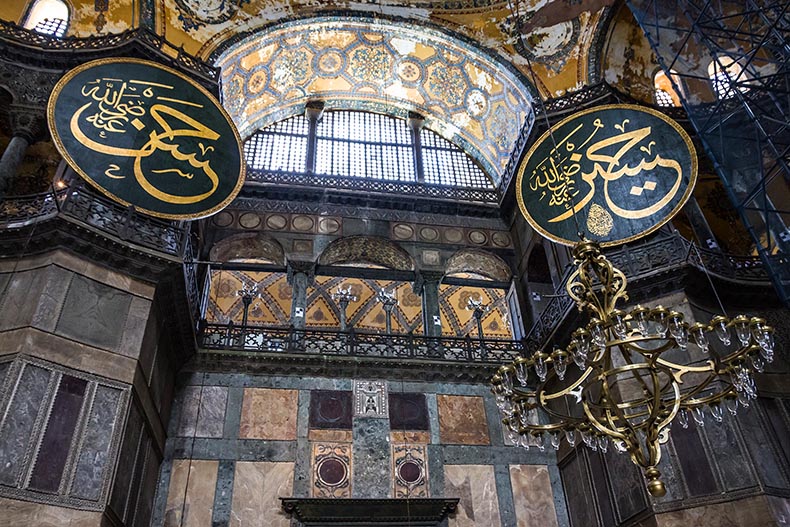
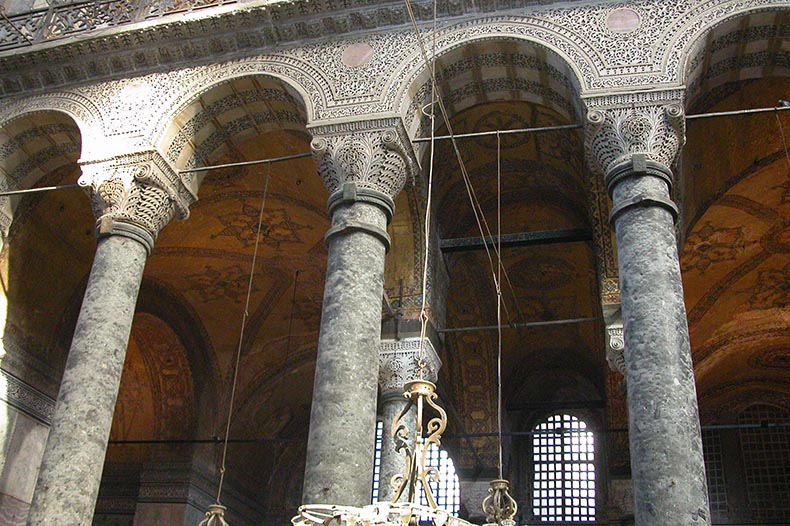
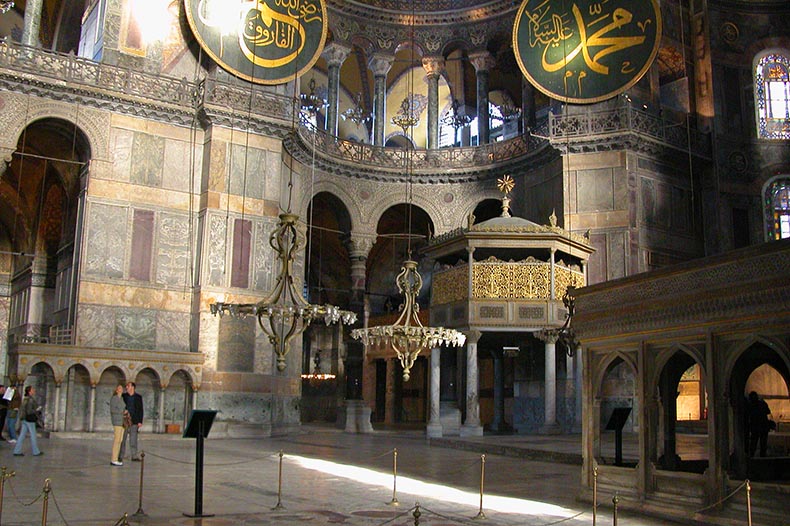
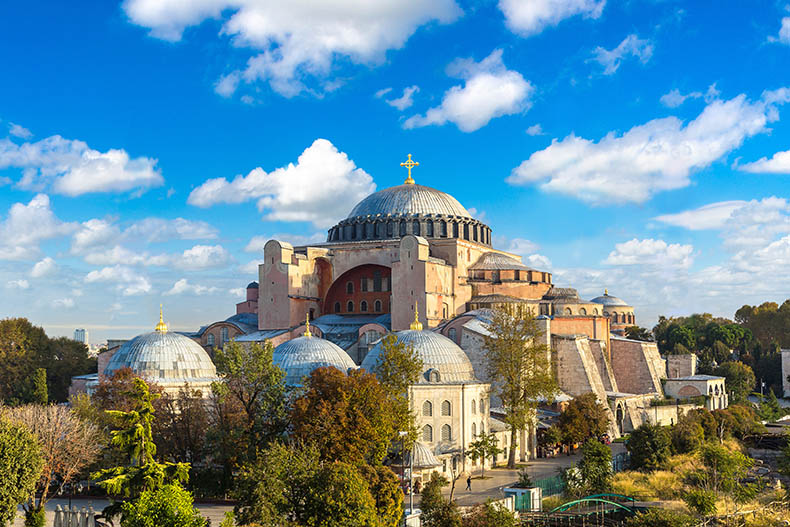 Above here's a picture I altered in Photoshop - Hagia Sophia without minarets! One can see how much they drastically change the appearance of the building.
Above here's a picture I altered in Photoshop - Hagia Sophia without minarets! One can see how much they drastically change the appearance of the building.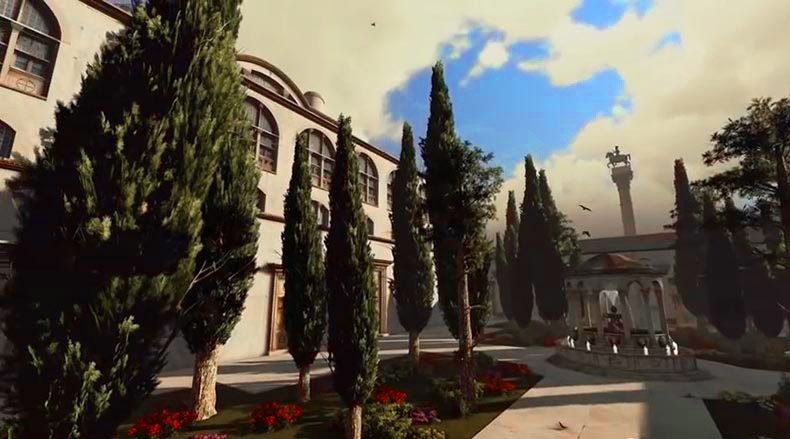
Above is a reconstruction of the atrium of Hagia Sophia showing the Column of Justinian in the distance. It's from the Byzantium 1200 website.
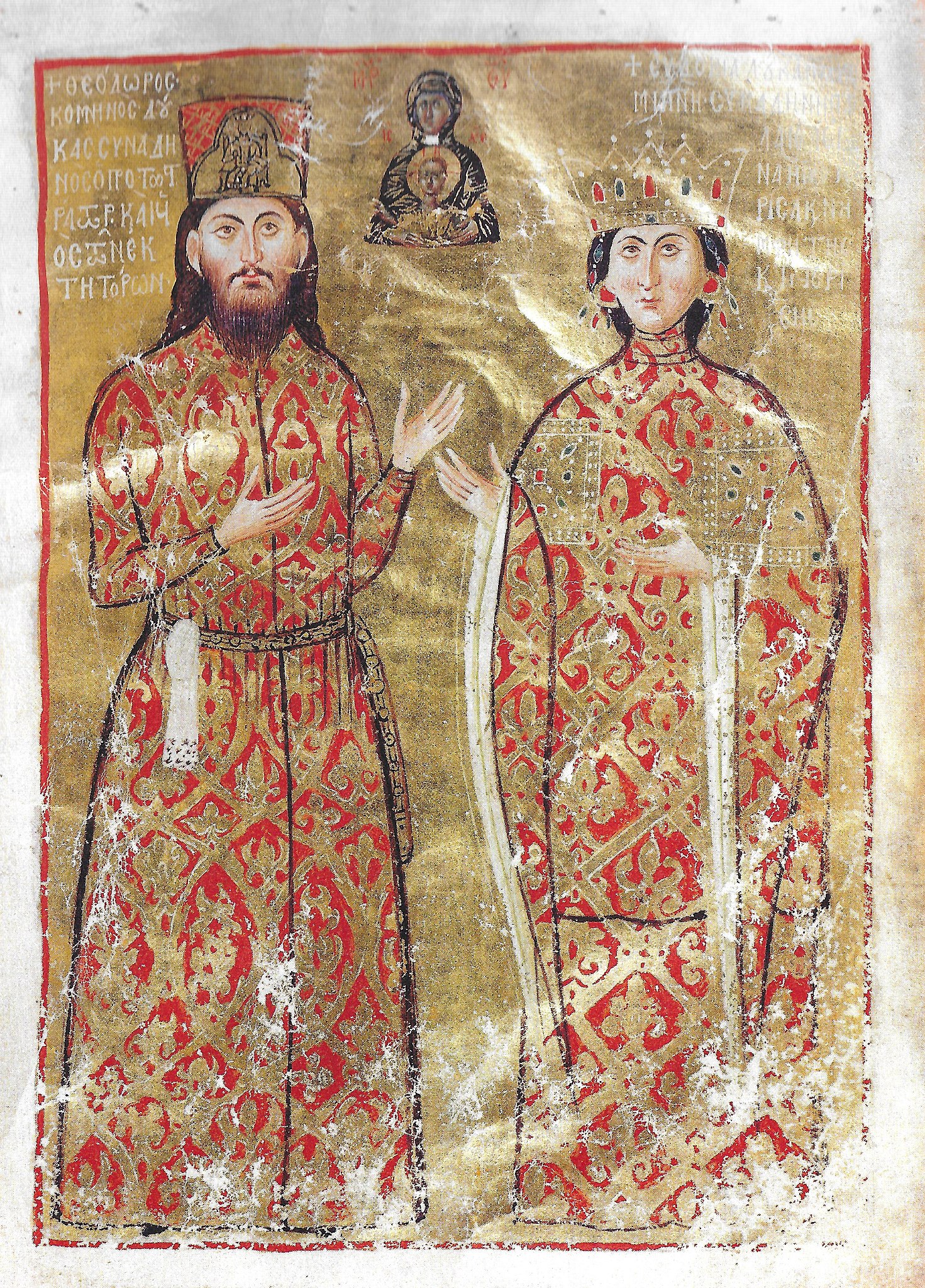 There was not much of value to be taken in the looting of the church. All of the 'treasures' of the church were made of silver that had been cheaply gilded. Everything that looked like it was gold was not. The covers of icons and gospel books were ripped off - only to find that their gems were glass and the gold only microns thick - a thin veneer. The books, despite their age and the beauty of their calligraphy and illumination, had no value to the pillagers and could be traded for a few copper coins. Most of them were destroyed or collected in piles like garbage to be swept away in the clean-up in the aftermath of the fall of the city. The famous icon of the Hodegetria, that the faithful believed had been painted by Saint Luke and that had survived 1204 was split into pieces and burned. The precious vestments, the work of generations of embroiders and textile artists, were ripped up to extract their gold thread, which turned out to be gilt-silver and worthless as loot. The lack of gold and silver loot in the church must have made the conquerors very angry and would have made them take it out on their victims. The only value in the church was in the people who could be sold into slavery, extorted for ransom or robbed of their possessions.
There was not much of value to be taken in the looting of the church. All of the 'treasures' of the church were made of silver that had been cheaply gilded. Everything that looked like it was gold was not. The covers of icons and gospel books were ripped off - only to find that their gems were glass and the gold only microns thick - a thin veneer. The books, despite their age and the beauty of their calligraphy and illumination, had no value to the pillagers and could be traded for a few copper coins. Most of them were destroyed or collected in piles like garbage to be swept away in the clean-up in the aftermath of the fall of the city. The famous icon of the Hodegetria, that the faithful believed had been painted by Saint Luke and that had survived 1204 was split into pieces and burned. The precious vestments, the work of generations of embroiders and textile artists, were ripped up to extract their gold thread, which turned out to be gilt-silver and worthless as loot. The lack of gold and silver loot in the church must have made the conquerors very angry and would have made them take it out on their victims. The only value in the church was in the people who could be sold into slavery, extorted for ransom or robbed of their possessions.
Alas, Hagia Sophia is still full of these innocent ghosts from the past. Thousands of people were then killed right in this holy place. Try to imagine what it was like to have been hiding inside Hagia Sophia with your family as the Turkish army was battering down the doors. The priests are saying the liturgy over and over again in perpetual prayers begging God to save them. There are 16,000 people - or more - packed in Hagia Sophia - everyone begins to scream and cry as they hear the Turks arrive outside. Suddenly the looters and the pillagers burst inside and the real terror begins. It's a mass slaughter. Those who are not killed or raped (women and boys, right there on the spot) are tied in chains and sold into slavery. Everyone is stripped in search of valuables. Their clothes are taken from them. The elderly, who have no value as slaves, are killed off one by one. The blood of the victims is everywhere. Imagine the horror and the cries for mercy, yet there was none to be had. Some converted to Islam on the spot in the hope of being spared. The church was full of bodies and there were huge piles of victims in the atrium.
One of the differences between the 1204 and 1453 was there was some restraint in the murder of innocent people in 1204. The crusaders were more interested in loot and treasure than sadism. There was plenty to take - everyone who participated in the looting had the potential to become rich beyond their wildest dreams without any guilt or remorse. The looting was fun and they were proud of their success. In theory their bishops and clergy told them to pillage and steal to their heart's content but to spare the women and children. This was not followed in practice, after the city surrendered there was a short period of mercy before the floodgates were opened by the first killings and rapes. Once the blood started to flow in the streets the victims were no longer innocents but scismatics and dangerous heretics who deserved death because they were intrinsically evil. It was said that the Latins who lived in Constantinople were the most cruel and vicious to their victims which included people they knew personally. The crusaders were told - and believed - that the possessions of the people of Constantinople had been granted to them by Christ as a reward.
In 1453 there was no need for anyone to bless the actions of the conquerors of the city. They were warriors of Islam and death was a just instrument of God on unbelievers. The taking of Constantinople had been ordered by the prophet himself and it was finally being fulfilled. A part of Mehmet's army were Christians and there is no religious excuse for what they did. It is amazing how cruel we can be to each other.
Everything inside the church - all of the icons that can be easily grabbed - were smashed to bits. It went on for hours and hours. The Turkish warriors went wild. They even mistook the colored marble floor panels to be precious stones. They hacked at them until Mehmet told them the buildings of the city were his and to stop damaging the property of the sultan.
When Mehmet II entered Hagia Sophia he brought an end to the carnage and then crawled on top of the altar and recited the Muslim Shahada, thus converting the church into a mosque. This moment was one of the great turning points of history. The world before and the world afterwards were two different places. For the next 250 years Europe was on the defensive against the Islamic Ottoman empire. That threat was finally ended in 1683 when John Sobieski lifted the two-month siege of Vienna and drove the Turks away from the city for the last time.
The only thing I can compare the conversion of Hagia Sophia to is the taking of Jerusalem by the First Crusade in 1089. In their taking of the city, after storming the walls, they literally bathed streets and holy places in Muslim and Jewish blood. When it was clear that every last man, woman and child had been murdered, they arrived at the Church of the Holy Sepulchre, full of joy, where they thanked God for both for this victory and the opportunity of killing thousands in His name. Soon after they converted the Holy Dome of the Rock into a church and made Al-Aqsa a palace, where they stabled their horses in the former sanctuary.
Like 1204 and 1453, the crusaders were were proud of what they had done, boasting about it for hundreds of years, absolutely assured had brought the true faith with them as holy warriors of God. Can you imagine what it would be like if Christians still had control of the Dome of the Rock and Al-Aqsa - a thousand years later? The holiest church of Orthodox Christianity was taken in a scene of barbarity that is still celebrated today as a great victory. I was reading an article in the Turkish press a few days ago that claimed in 1453 the people inside Hagia Sophia were happy and welcomed them as liberators. There was no massacre of innocent people there. The Nationalist Turks really believe this to be true.
To learn more about Hagia Sophia in Ottoman times go here.
The Turkish religious authorities decided to turn the 13th century Byzantine church of Hagia Sophia in Trabzon - which had been a museum for 60 years - into a mosque. In 2012, the religious authorities (Diyanet) filed a lawsuit against the ministry of culture, claiming the ministry had been 'illegally occupying' the church for some decades. The church had been a treasure box of beautiful frescoes that were one of the greatest works of art anywhere at the time. They had recently been restored to their former glory. Despite the fact that there were dozens of functioning mosques nearby, the Turkish religious authorities decided they had to have this museum turned back into a mosque. They covered up the frescoes, again. Obviously, the Turks could not keep the news of the conversion out of the press and word got out that the Turks were destroying a great monument of Byzantine art. Many tourists came to Trabzon to see Hagia Sophia specifically. Tourism dropped off right away, and local businesses saw what a stupid move like this could do to them. How long this will last or how it will end, I don't know. It was announced in December 2017 that the wooden covers placed over the frescoes would be removed due to the sharp decline in tourism. The September 2018 decision of the Turkish Supreme Court banning the re-conversion of Hagia Sophia to a mosque will, hopefully stop this happening here.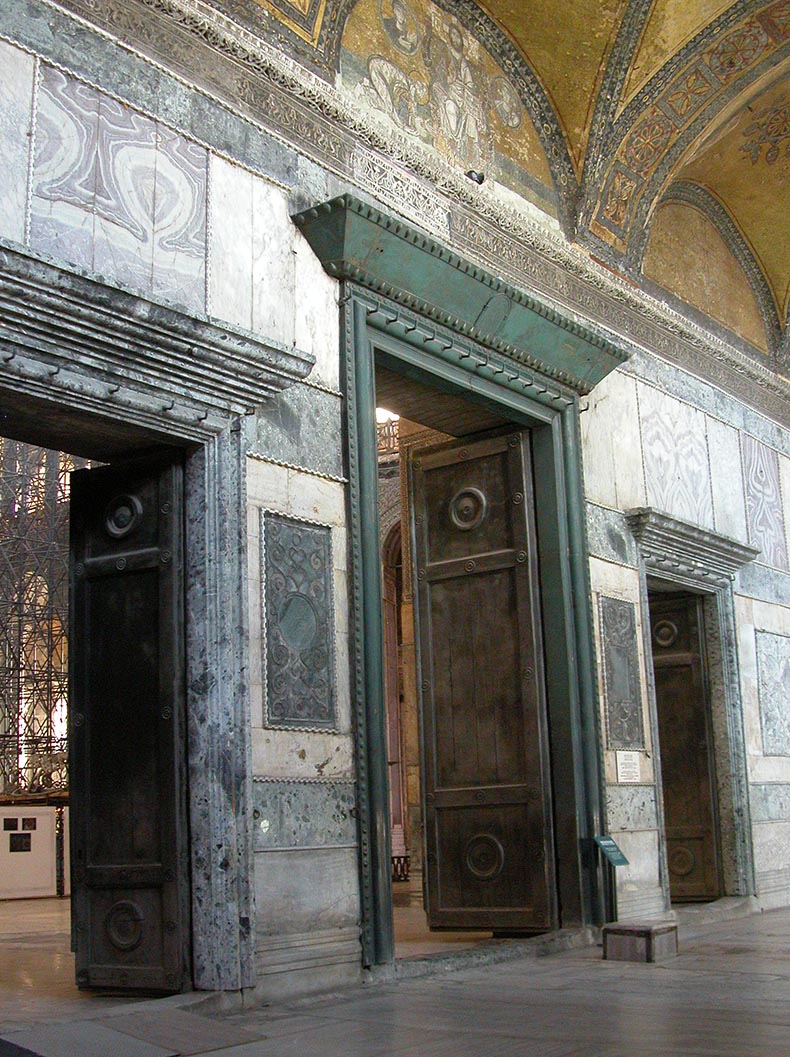 Above, here are the Royal Doors - the frame is made of brass and dates the reign of Leo the Wise whose mosaic portrait is above it. The wood was supposed to have come from Noah's Ark. At one time these doors were covered in plates of gilt-silver.
Above, here are the Royal Doors - the frame is made of brass and dates the reign of Leo the Wise whose mosaic portrait is above it. The wood was supposed to have come from Noah's Ark. At one time these doors were covered in plates of gilt-silver.
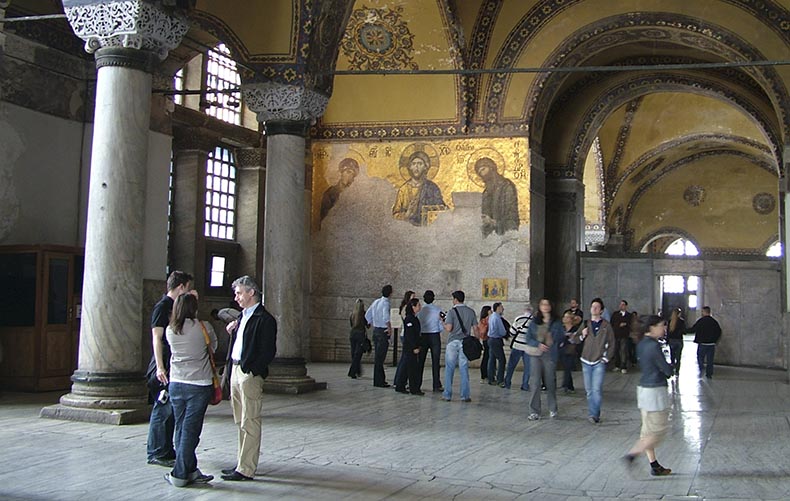
Now to return to the Deesis - it was a 12th century addition to the South Gallery. Above, looking west, we can see the mosaic. During Byzantine times this area of the church was reserved for members of the Imperial family and the court who viewed the liturgy from the eastern-most bay of the church. A spiral wooden staircase and passageway connected this part of the church directly to the Great Palace. You can still see where it attached on the outside of the church and find inscriptions scratched onto marble doorways both inside and outside around the doorway. The door was to the far right of the mosaics of Constantine-Zoe and John and Eirene. The door still functions but it opens into open air.
Hagia Sophia is full of graffiti - drawings and inscriptions that can be found throughout the building. There are some amazing things; from drawings of dragon-headed Viking ships to a blessing hand with attached prayers asking for God's help for a man named Michael. There is a Byzantine scholar who is compiling hundreds of these into a database.
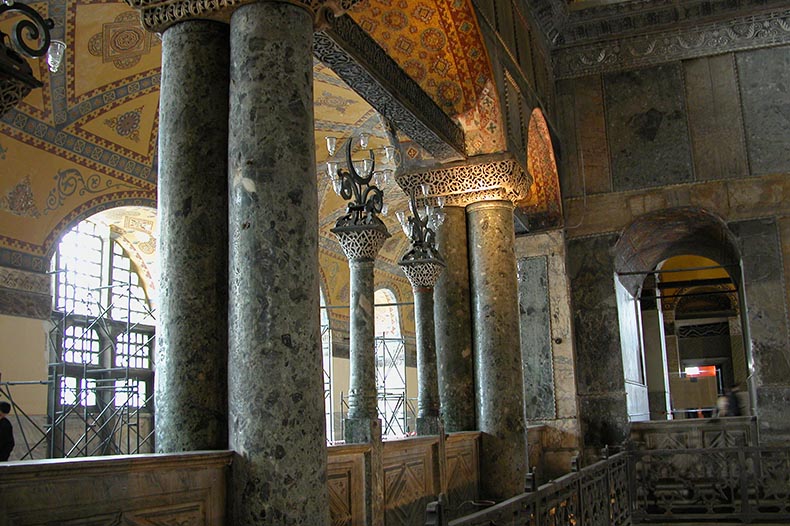 The marble walls are punched with phantom holes where crosses used to be inserted and have been pried out. The hooks that icons hung from are still there on the walls - memorials to the vanished art that used to be there. In many cases we actually know what icon is missing from which hook. The ceiling still has hundreds of hooks for the hanging of curtains and lamps. Just look up and they're there. Look at the floor and you can see the markings where the Byzantine Imperial throne stood. More marks show where candle stands were. Look at the doors of Hagia Sophia and see how the crosses were broken off them. You can hear people shout or sing in the nave to test the acoustics; listen and I try to imagine an Imperial choir in the echo. Is it true that the last priest who celebrated mass in the church took his holy chalice and was swallowed up into a wall, someday to reappear? Well, that's the story the Greek or Russian guides tell. It may actually relate to a true story about Hagia Sophia. There used to be a long chapel across the back behind the apse. It was called the Chapel of Saint Nicholas. The chapel was walled up and sealed into the big buttresses Andronikos II built against the back of the church. There is still a door in the south wall that lead into the chapel that leads nowhere today. Its possible there is something to be discovered there, perhaps mosaics or paintings.
The marble walls are punched with phantom holes where crosses used to be inserted and have been pried out. The hooks that icons hung from are still there on the walls - memorials to the vanished art that used to be there. In many cases we actually know what icon is missing from which hook. The ceiling still has hundreds of hooks for the hanging of curtains and lamps. Just look up and they're there. Look at the floor and you can see the markings where the Byzantine Imperial throne stood. More marks show where candle stands were. Look at the doors of Hagia Sophia and see how the crosses were broken off them. You can hear people shout or sing in the nave to test the acoustics; listen and I try to imagine an Imperial choir in the echo. Is it true that the last priest who celebrated mass in the church took his holy chalice and was swallowed up into a wall, someday to reappear? Well, that's the story the Greek or Russian guides tell. It may actually relate to a true story about Hagia Sophia. There used to be a long chapel across the back behind the apse. It was called the Chapel of Saint Nicholas. The chapel was walled up and sealed into the big buttresses Andronikos II built against the back of the church. There is still a door in the south wall that lead into the chapel that leads nowhere today. Its possible there is something to be discovered there, perhaps mosaics or paintings.
Originally the vaults of the south gallery were covered with mosaics of Pentecost, Seraphim, Christ and the Saints. As I mentioned earlier this all appears to have came down in an 1894 earthquake. We are lucky we have very detailed drawings from the 1700's that document them - and we also have texts describing them. Here's a watercolor from 1850 by Saltzenberg showing the mosaics in the vaults of the South Gallery. When he was in Hagia Sophia Saltzenberg remarked on the extraordinary beauty of this mosaic and how you could see it very well from the nave - sparkling in the sunshine. We just don't know what happened between 1850 and 1930 - but they vanished. 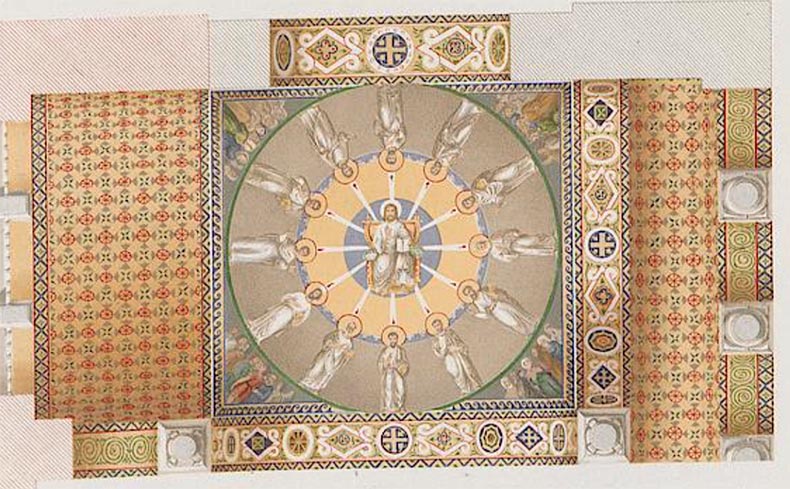 The south gallery was originally for women, but later it became a part of the Patriarchal palace on this side of Hagia Sophia. The imperial family would process along the wooden walkway from the palace and enter the church here, where the clergy would great them. The clergy of the Great Church was among the best educated and most sophisticated culturally of Byzantium's citizens. The South Gallery was magnificent and had some of the finest art to be found in the Hagia Sophia. The Deesis was, perhaps, the apogee of Byzantine art and spirituality. We are glad it has survived when so much in Hagia Sophia has been lost forever.
The south gallery was originally for women, but later it became a part of the Patriarchal palace on this side of Hagia Sophia. The imperial family would process along the wooden walkway from the palace and enter the church here, where the clergy would great them. The clergy of the Great Church was among the best educated and most sophisticated culturally of Byzantium's citizens. The South Gallery was magnificent and had some of the finest art to be found in the Hagia Sophia. The Deesis was, perhaps, the apogee of Byzantine art and spirituality. We are glad it has survived when so much in Hagia Sophia has been lost forever.
Hagia Sophia still has many secrets to reveal. There might still be more mosaics to be discovered. There are photographs of chambers in the buttresses with mosaic figures from 80 years ago. Are they still there? What happened the the beautiful acanthus mosaic vaults in the hidden chambers on the south side? Is the Pantokrator still in the central dome? In the latest studies we are told it's gone. When did it come down? There is a Fossati watercolor of a huge Pantokrator mosaic that is obviously from a dome. Some people have speculated that this means the Pantokrator survived until the mid 19th century. This watercolor can be seen below:
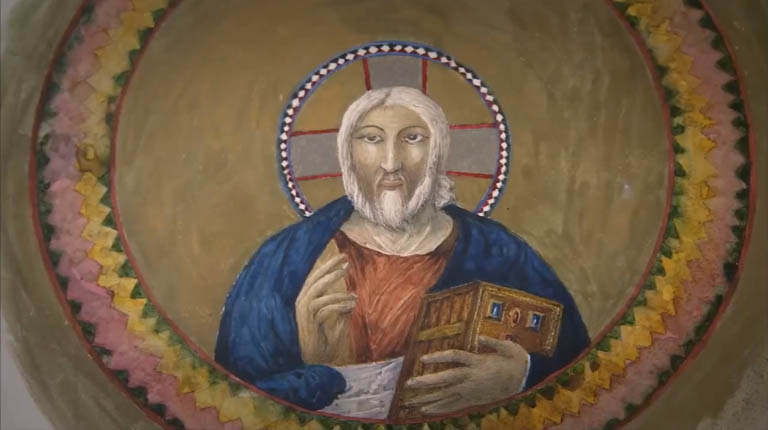 It is obvious that this is not the Pantokrator in the main dome. It is a giant mosaic that was in the South Gallery in the far eastern vault where the Seraphim and Cherubim were. This figure was twice life size and the same size as the Deesis Christ. Here is a greatly enlarged drawing of it from the early 18th century, you can see it has the same border. It also tells us the mosaic here in the South Gallery survived until at least 1850. You can read more about these mosaics here.
It is obvious that this is not the Pantokrator in the main dome. It is a giant mosaic that was in the South Gallery in the far eastern vault where the Seraphim and Cherubim were. This figure was twice life size and the same size as the Deesis Christ. Here is a greatly enlarged drawing of it from the early 18th century, you can see it has the same border. It also tells us the mosaic here in the South Gallery survived until at least 1850. You can read more about these mosaics here.
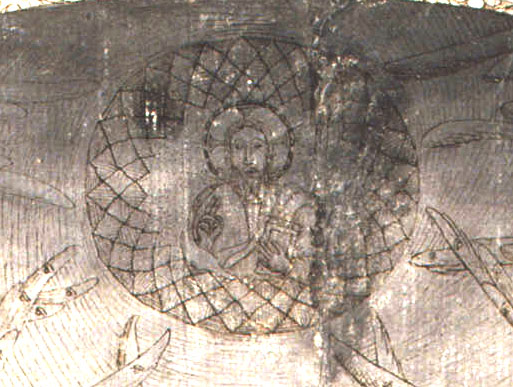
Where did the columns of the great chancel screen and all of the other marble liturgical furniture go? Are they in Topkapi? I think they are. Here are a pair of candidates in Verde Antique marble. They might be the right size and originally had chancel panels between them. I remember seeing these columns many years ago and there were at least 12 of them.
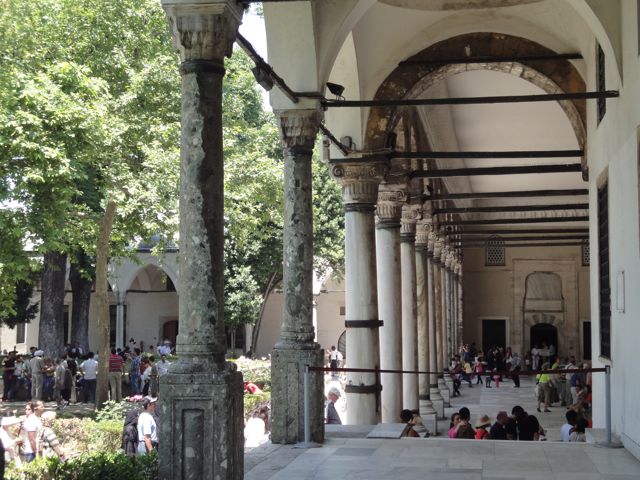
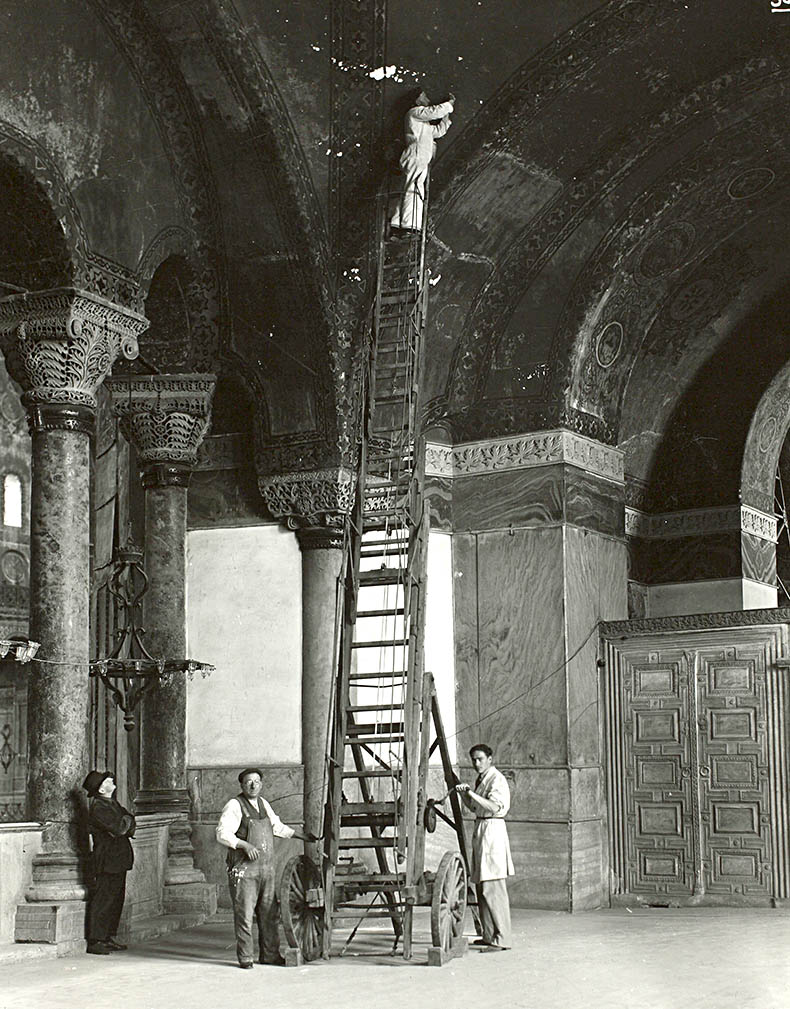
We really have to be thankful and eternally grateful to what was the Byzantine Institute of America and the team of restorers who saved the Deesis; and all the other mosaics that are still with us. What a job it was. The image above shows the scale of the upper gallery. How many restorers were there six, ten, less than 15 for sure. Here we see Thomas Whittemore and other conservators working on the vaults of the gallery in the 1930's. Thomas Whittemore can be seen at lower left wearing a dark hat looking up. Whittemore became the public face of the recovery and restoration of the mosaics. It has been claimed that he had ll of his reports ghost-written in Paris by another Byzantinist. I know how it feels to be a terrible writer - I wish I had someone to ghost write this website! Some of the restorers suffered from vertigo and still managed to get to the tops of these things. I have read that some of them were terrified working on the scaffold in the apse. I hate heights, too, so I would have been in the same boat with them. One of my greatest terrors was climbing all over the roof of the Pantokrator in cowboy boots. I was offered the opportunity to climb up onto the roof of Hagia Sophia and then onto the dome cornice. I had to pass it up!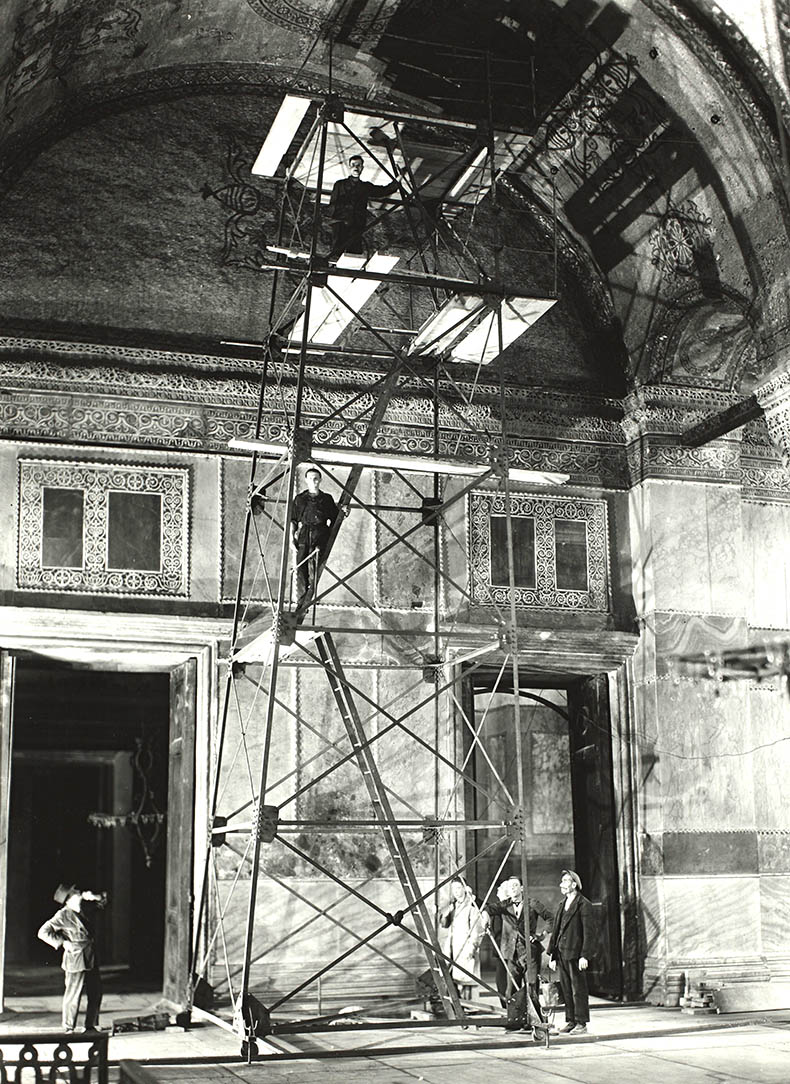

The plan above shows the location of the mosaic, which is open to the public today. It is a must-see for anyone visiting Istanbul. Hordes of tourists take selfies in front of it everyday. However, no photograph does the mosaic justice. The Deesis mosaic is the most perfect example of the Byzantine craft of mosaic and possesses every "trick of the trade" in the subtle play of light and color they built into it. The skilled and varied placement of the mosaic cubes - and the raking exterior light creates a shimmer of light that cannot be captured by a camera. As the light changes during the day the Deesis changes, too - in beautiful ways, The best way to appreciate it would be alone, without the crowds so one could contemplate the mosaic and its magical environment. If you are on a private tour and with a scholarly organization this such things are still possible.
Many consider the Deesis among the greatest treasures of world art. Some Christians call it the finest representation of Christ in the Eastern Orthodox world. Some consider its survival a sign to us today. I am not sure what the sign is. Most of the mosaic has been lost. It is miraculous that the faces and so much of Christ and John the Baptist are still there to look at us look at them. Perhaps, Christ has saved this mosaic of Himself for us as a symbol of the power of God in art and beauty and how it can survive the horrors we create. I have thought it might be that the myth of the Priest entering the wall with the host in 1453 is really here in the Deesis. Christ has survived and is still with us on the wall of the South Gallery. I have never met anyone of any faith who has not been moved by this image of Christ.
In 2009 the museum authorities at Hagia Sophia removed an Ottoman star that had been placed over the face of the great mosaic of a seraphim in the left pendentive in the eastern arch of the church. The seraphim angels in the two eastern pendentives were cleaned in 2010 and 2011. The star covering the face of the right seraphim was not removed, we can assume the face is still there. The mosaics in the dome were cleaned and studied for ten years beginning in 1992. This work identified and published of all of the phases of the decorative work in the dome from the 6th century until today. I was surprised by how much work was done from 1894-1909. It seems the entire center medallion in the dome was brutally replaced. This may have been the time when the mosaics in the vaults of the South Gallery were destroyed. Over a series of several months in 1937 the scaffolding in the South Gallery was moved around searching for more mosaics. They didn't find any. However, in 1950 Paul Underwood made additional tests in the south wall of the east end of the South Gallery for new mosaics. They found some. I have never seen anything other than these notes that describes them.
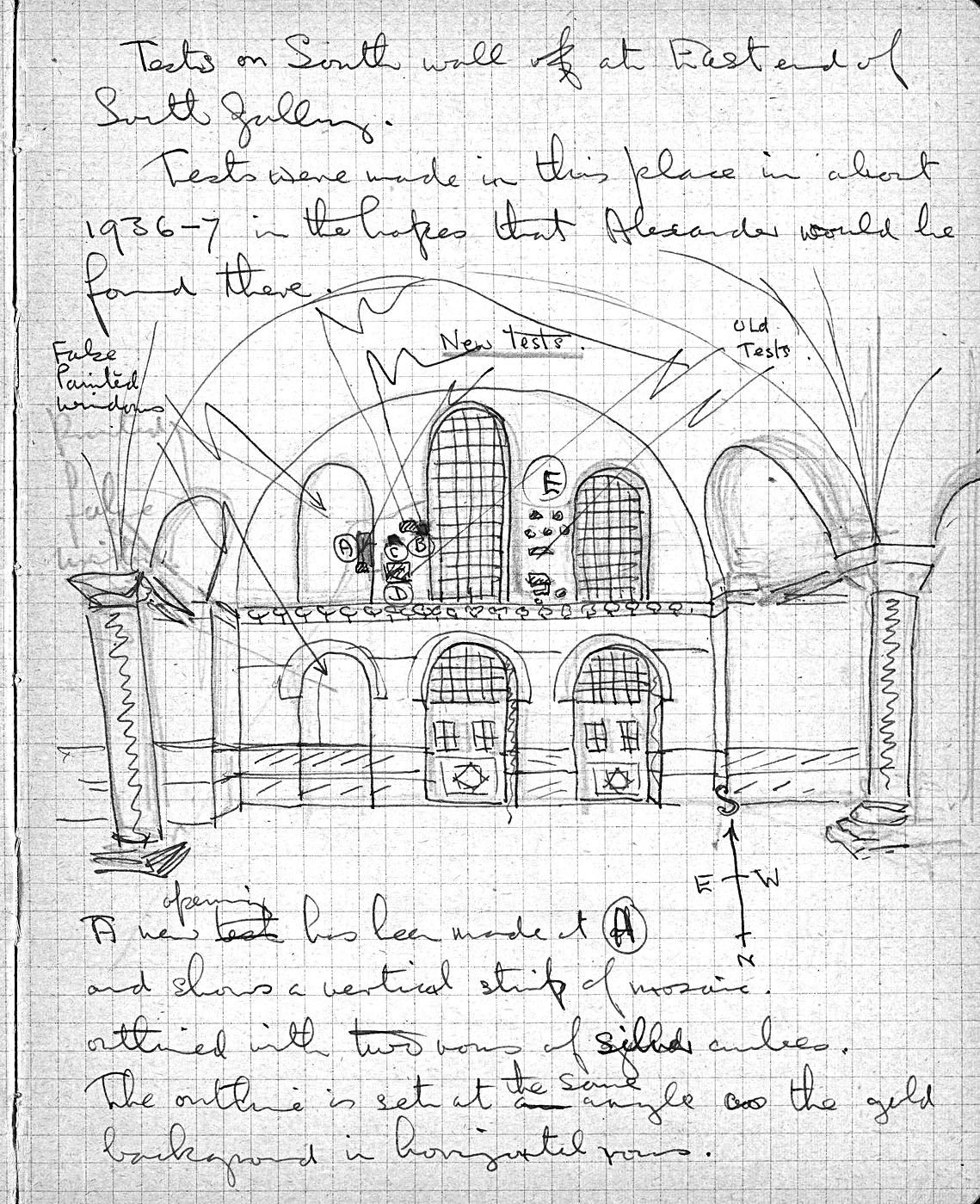
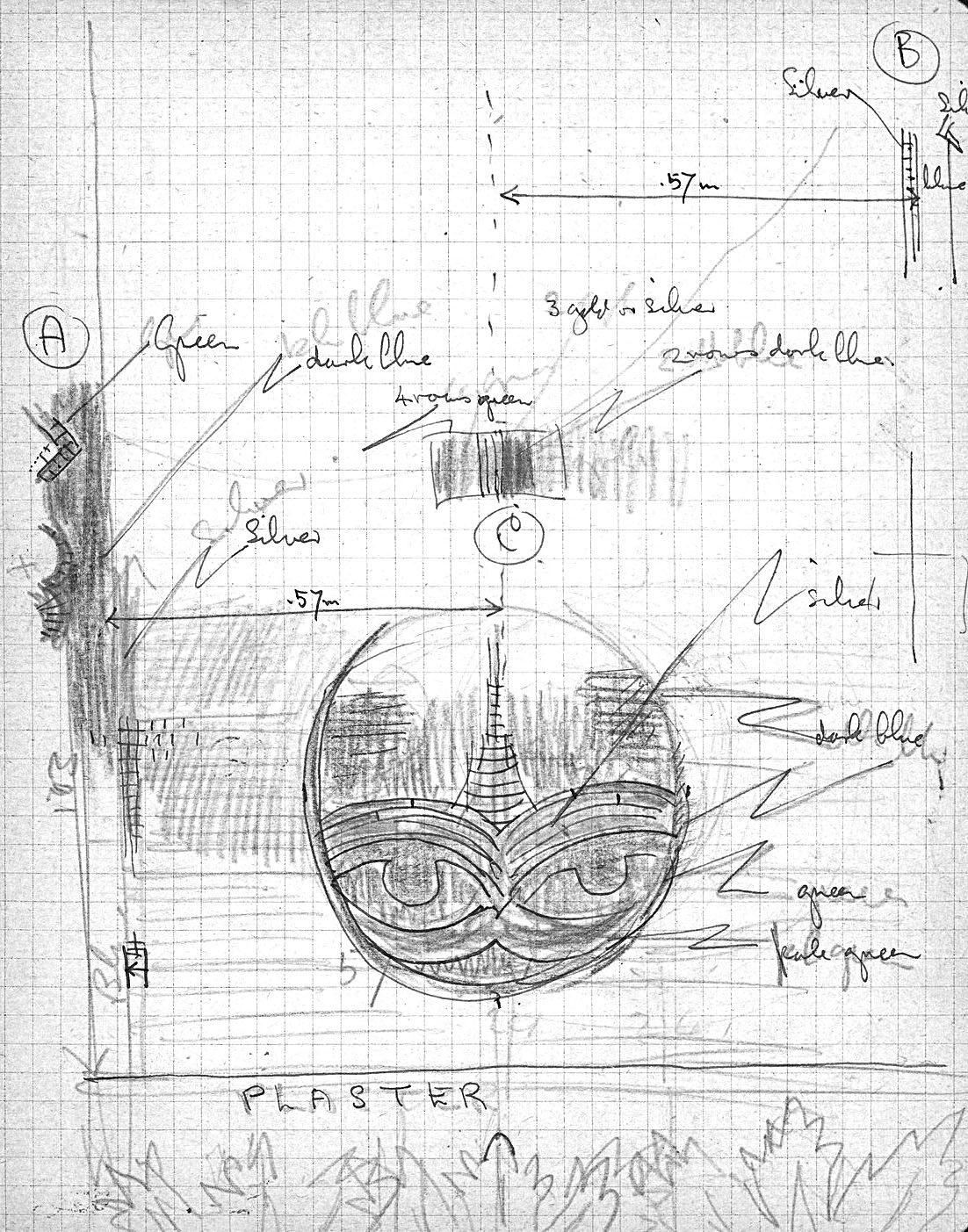
In 1992 soundings and probes were done in the central medallion looking for traces of the mosaic of Christ Pantokrator. They reported that they found two layers of 14th century plaster but no setting bed for the mosaic tesserae. Cyril Mango believes the mosaic was probably lost between 1652 and 1672. I have to say I am not entirely convinced by the 1992 findings, the Turks don't have the best record in documentation and publication of their findings. Over the last 50 years a number of fishy things have happened in Hagia Sophia and there have been cover-ups by the authorities. Look at the sad fate of the Beautiful Doors to the church that has been kept secret until Robin Cormack exposed the truth.

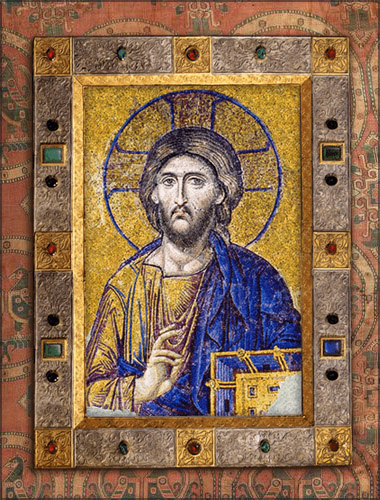


![]()



![]()


 click here for icons of christ
click here for icons of christ click here for icons of the theotokos
click here for icons of the theotokos click here for icons of angels
click here for icons of angels click here for icons of saints
click here for icons of saints